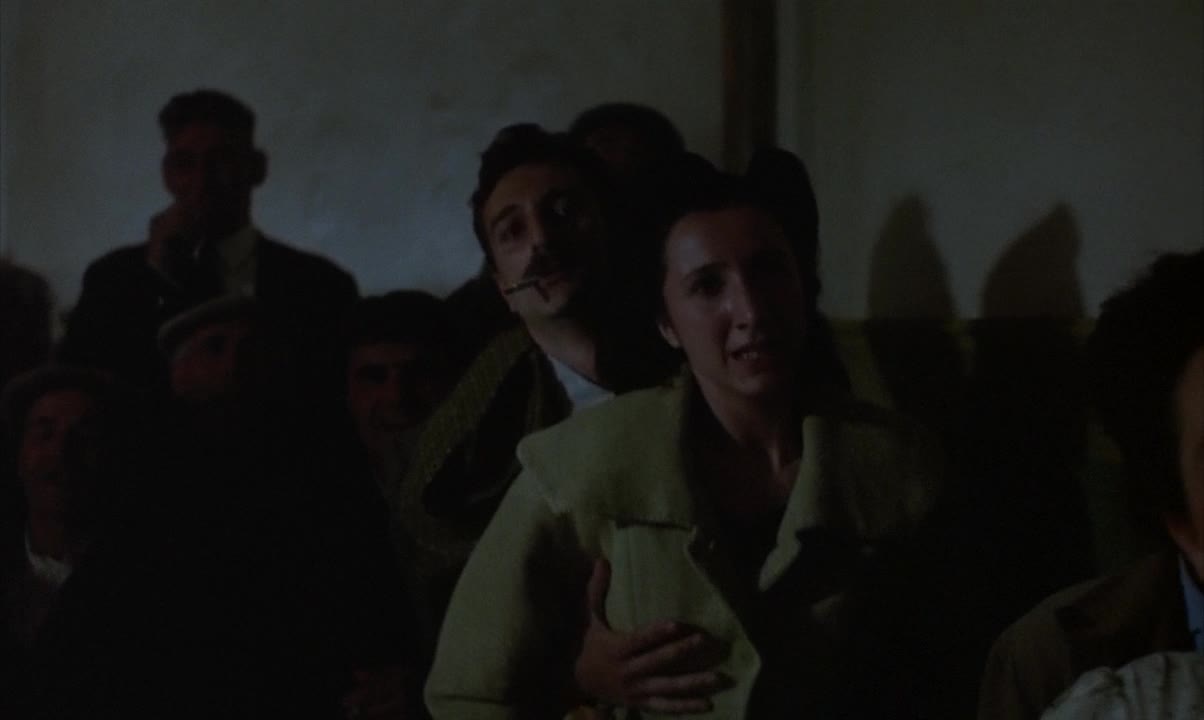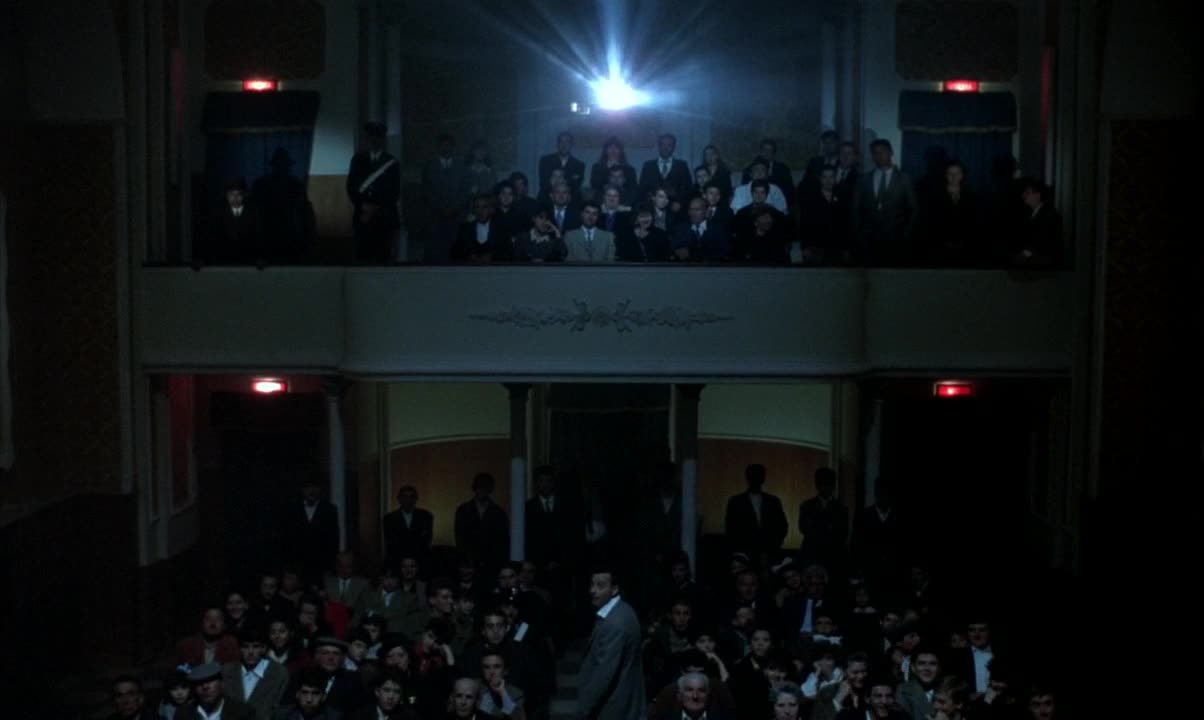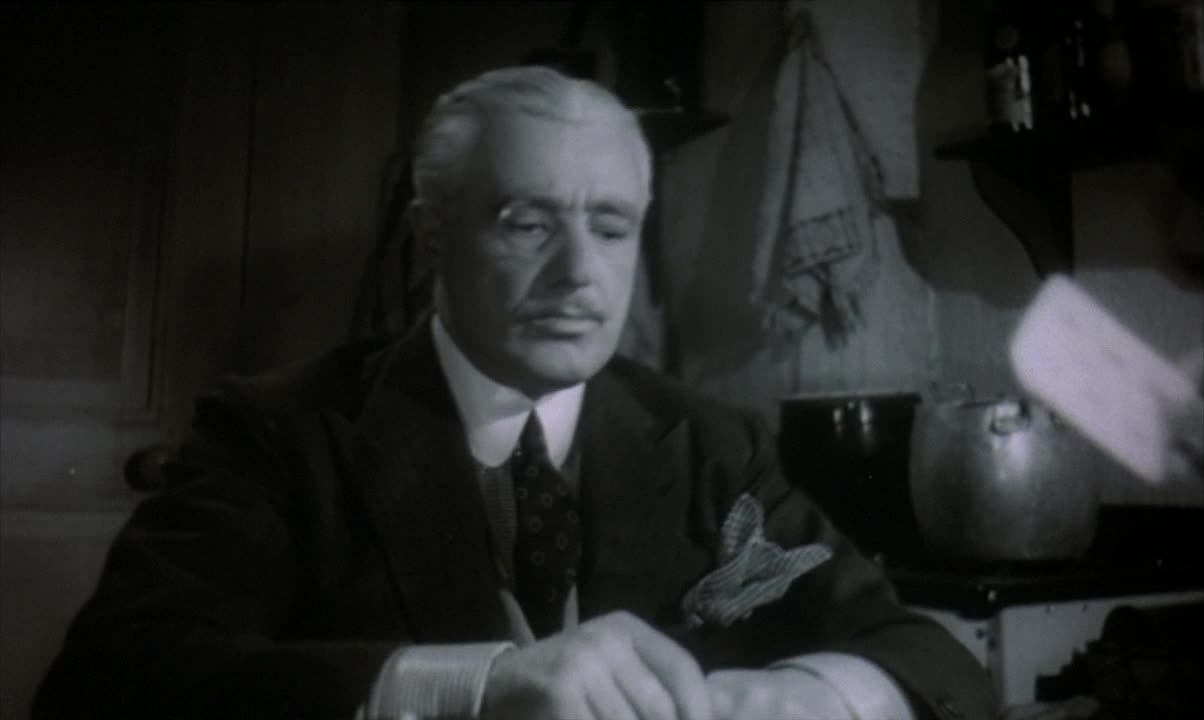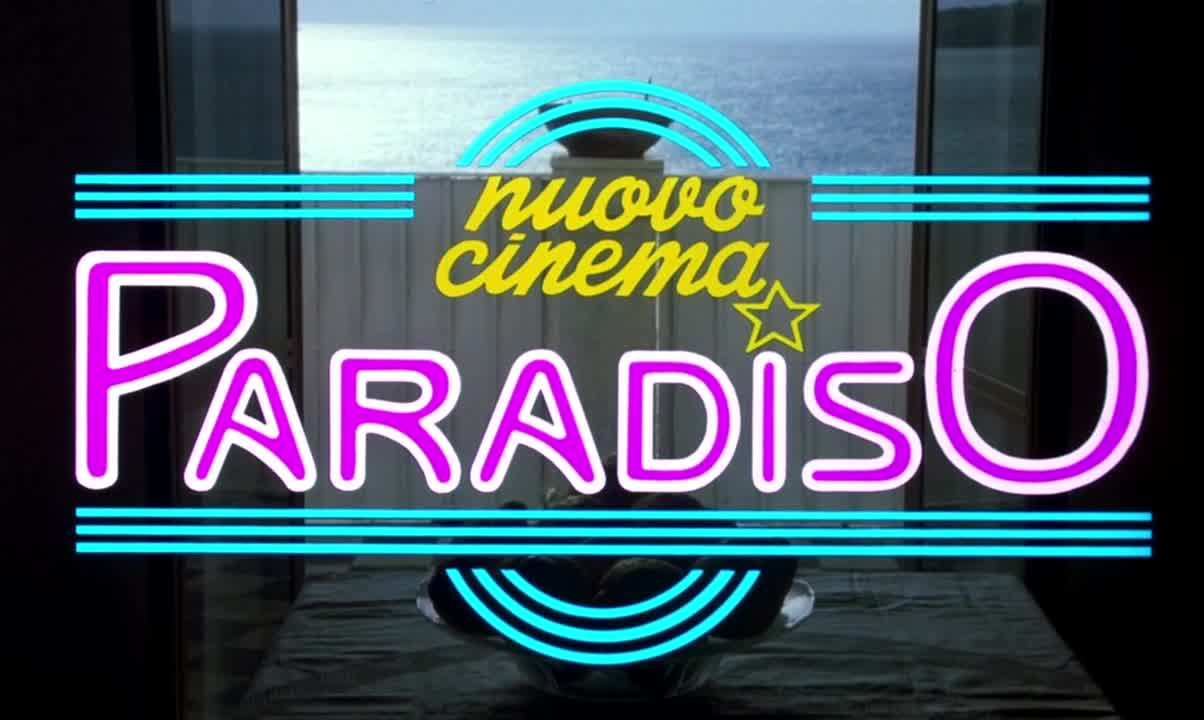 We celebrate the 300 posts of Films in Films with an extensive look into the endless film references from Nuovo Cinema Paradiso (1988). Giuseppe Tornatore’s sentimental tale of how a young boy’s life was affected by the local cinema and its projectionist. The film contains an enormous number of other film references in the form of screenings and posters. Most of them are listed below.
We celebrate the 300 posts of Films in Films with an extensive look into the endless film references from Nuovo Cinema Paradiso (1988). Giuseppe Tornatore’s sentimental tale of how a young boy’s life was affected by the local cinema and its projectionist. The film contains an enormous number of other film references in the form of screenings and posters. Most of them are listed below.
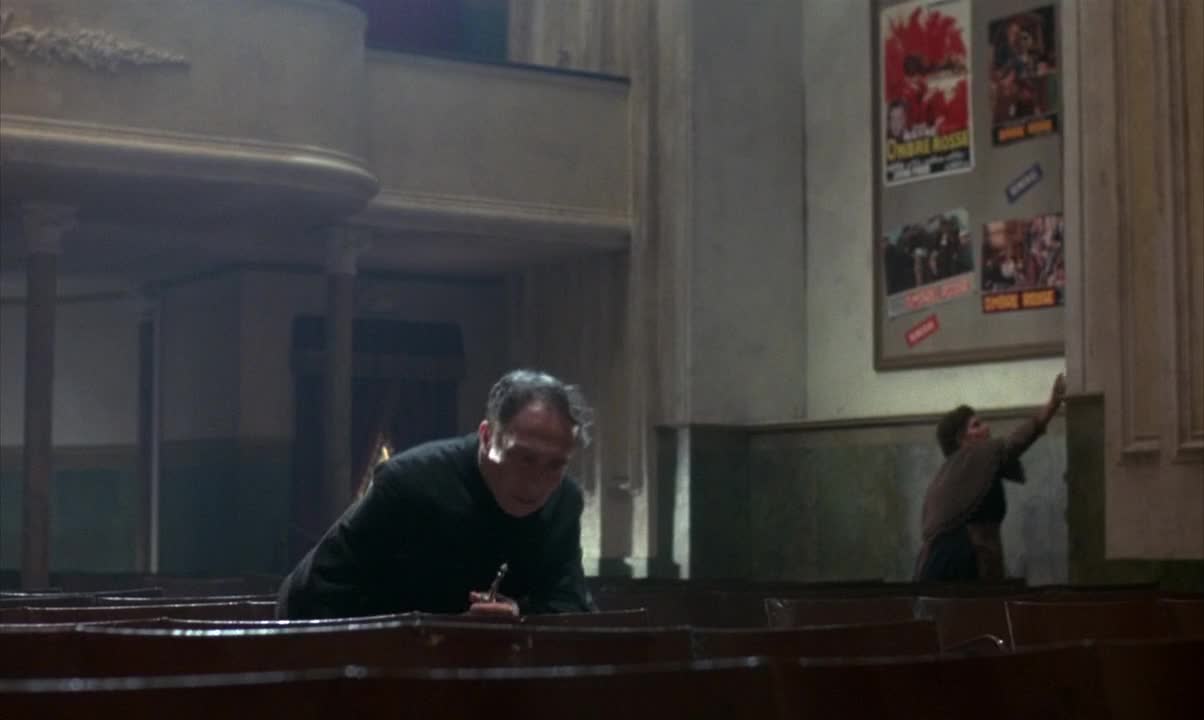 Our first encounter with the interior of Cinema Paradiso is when Father Adelfio’s private screening of next week’s film starts, in order to examine possible immoral scenes.Behind him, we can see Italian posters of John Ford’s Stagecoach (1939), aka Ombre Rosse.
Our first encounter with the interior of Cinema Paradiso is when Father Adelfio’s private screening of next week’s film starts, in order to examine possible immoral scenes.Behind him, we can see Italian posters of John Ford’s Stagecoach (1939), aka Ombre Rosse.
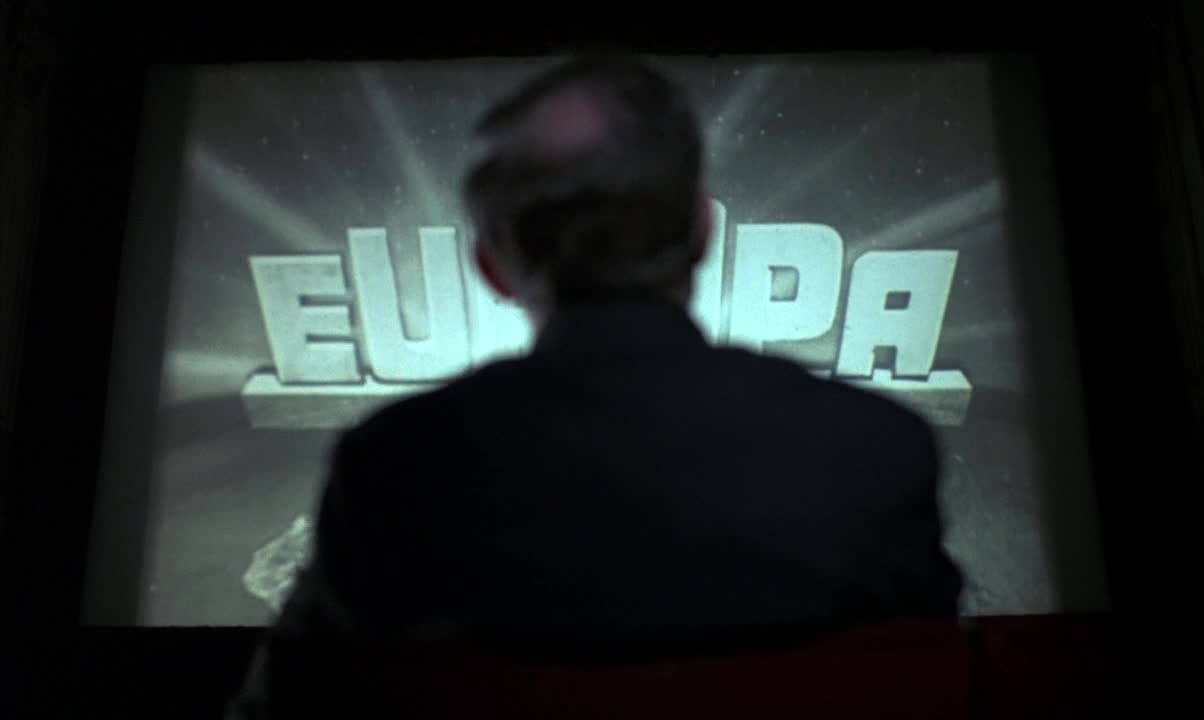
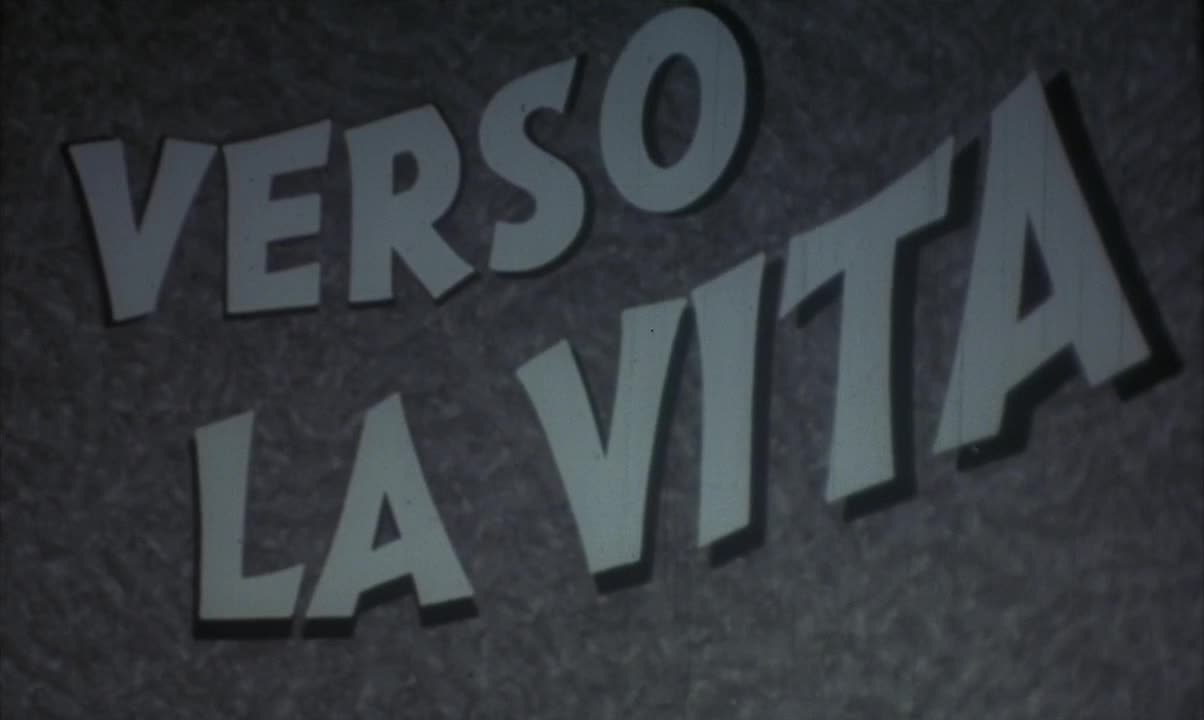
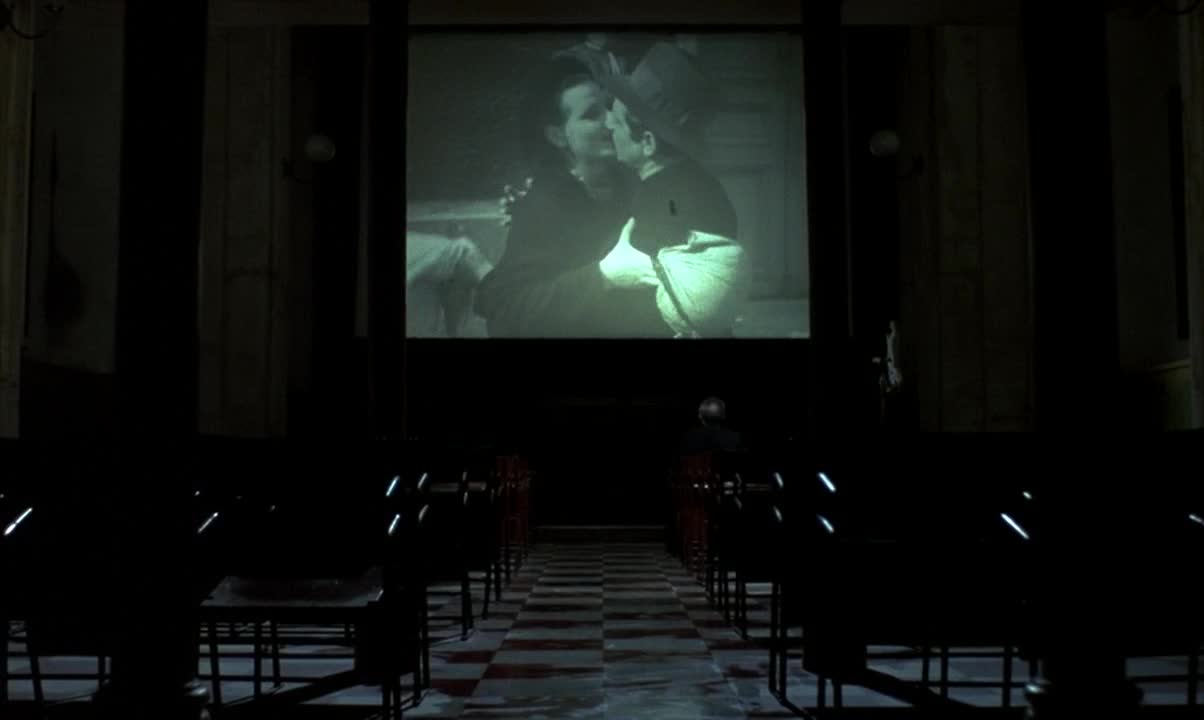 The film that Father Adelfio watches is Jean Renoir’s Les bas-fonds (1936), aka Verso la Vita. He becomes angry with the kissing scene and orders Alfredo to cut it.
The film that Father Adelfio watches is Jean Renoir’s Les bas-fonds (1936), aka Verso la Vita. He becomes angry with the kissing scene and orders Alfredo to cut it.
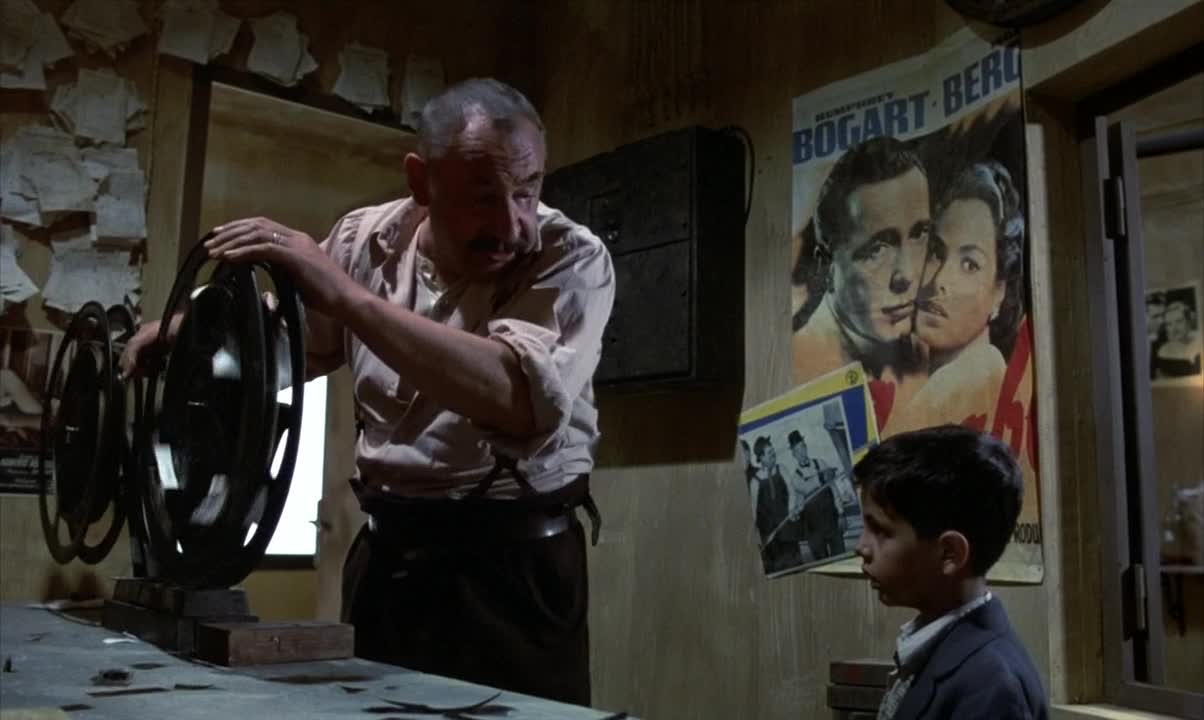 Little Toto visits the projection room, where Alfredo recuts films. Behind hilm, under a Laurel-Hardy still, there is a ripped poster of Michael Curtiz’s Casablanca (1942).
Little Toto visits the projection room, where Alfredo recuts films. Behind hilm, under a Laurel-Hardy still, there is a ripped poster of Michael Curtiz’s Casablanca (1942).
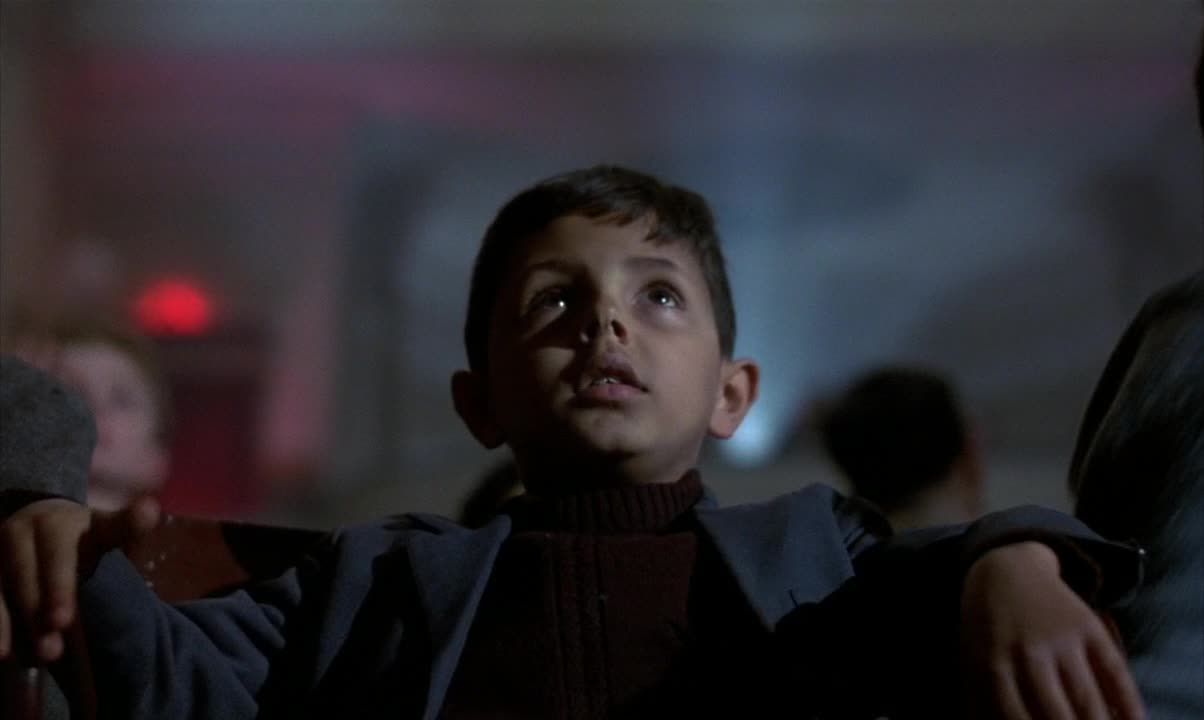
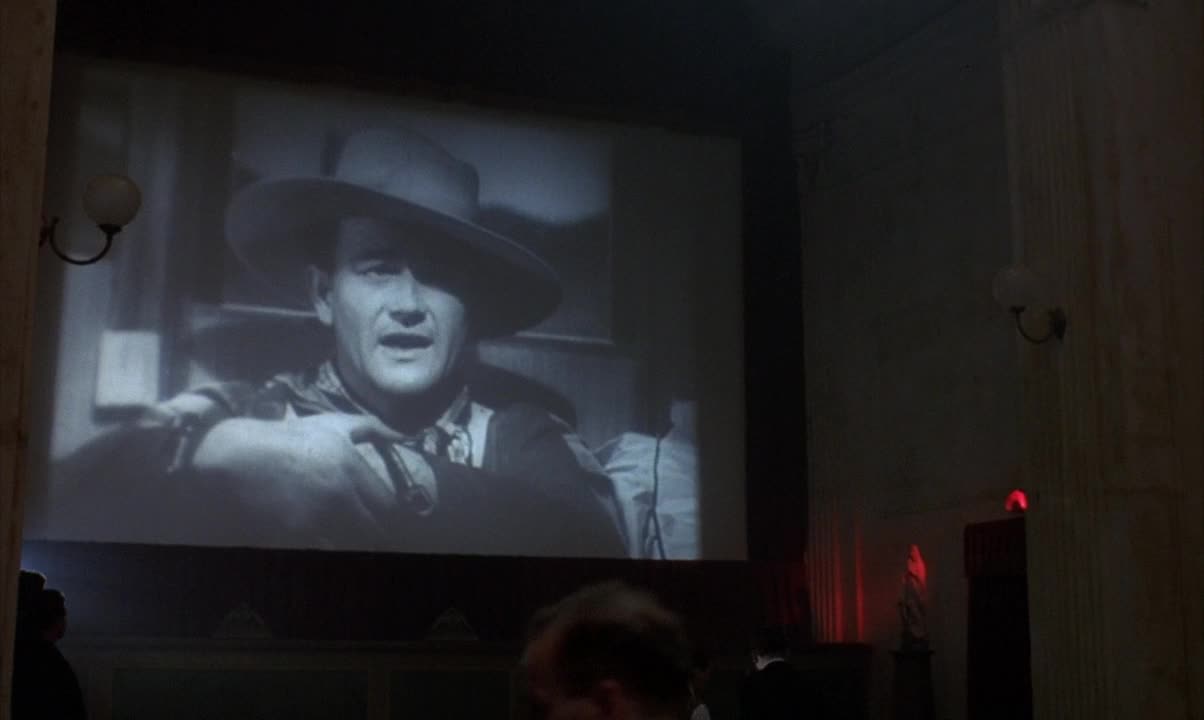 Toto not only sneaks into the projection room, but he also visits Cinema Paradiso as a paying customer. Before the double feature night starts, he watches the trailer of Stagecoach (1939).
Toto not only sneaks into the projection room, but he also visits Cinema Paradiso as a paying customer. Before the double feature night starts, he watches the trailer of Stagecoach (1939).
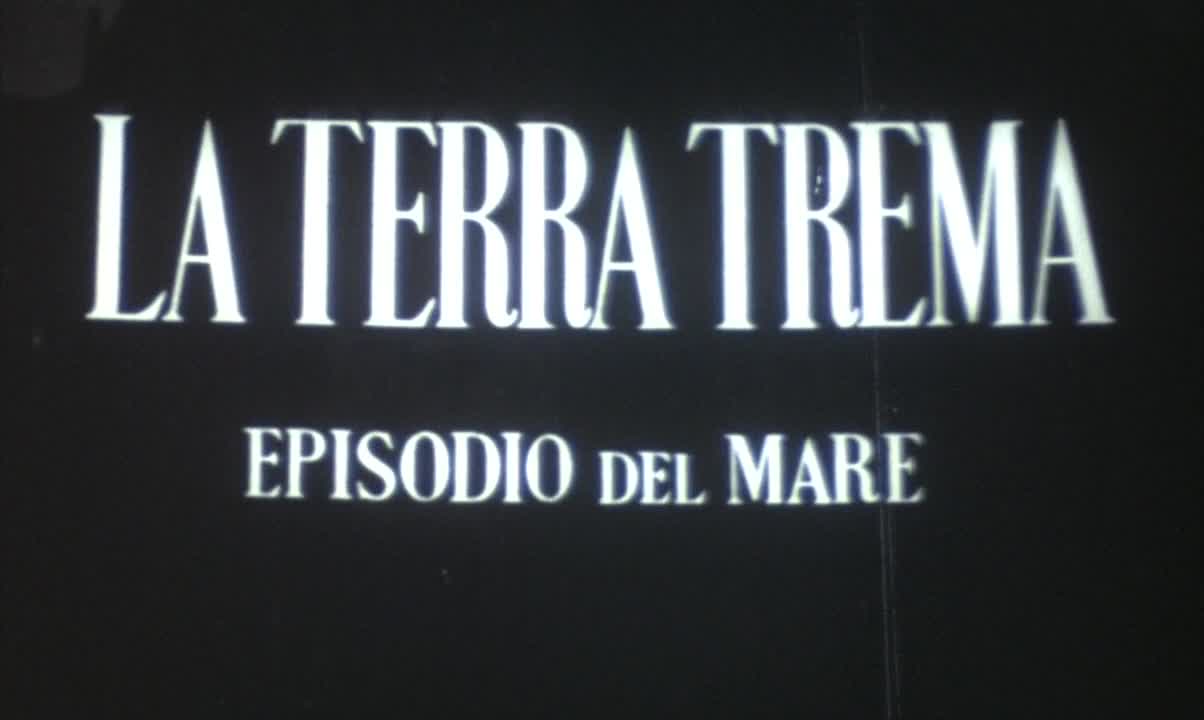
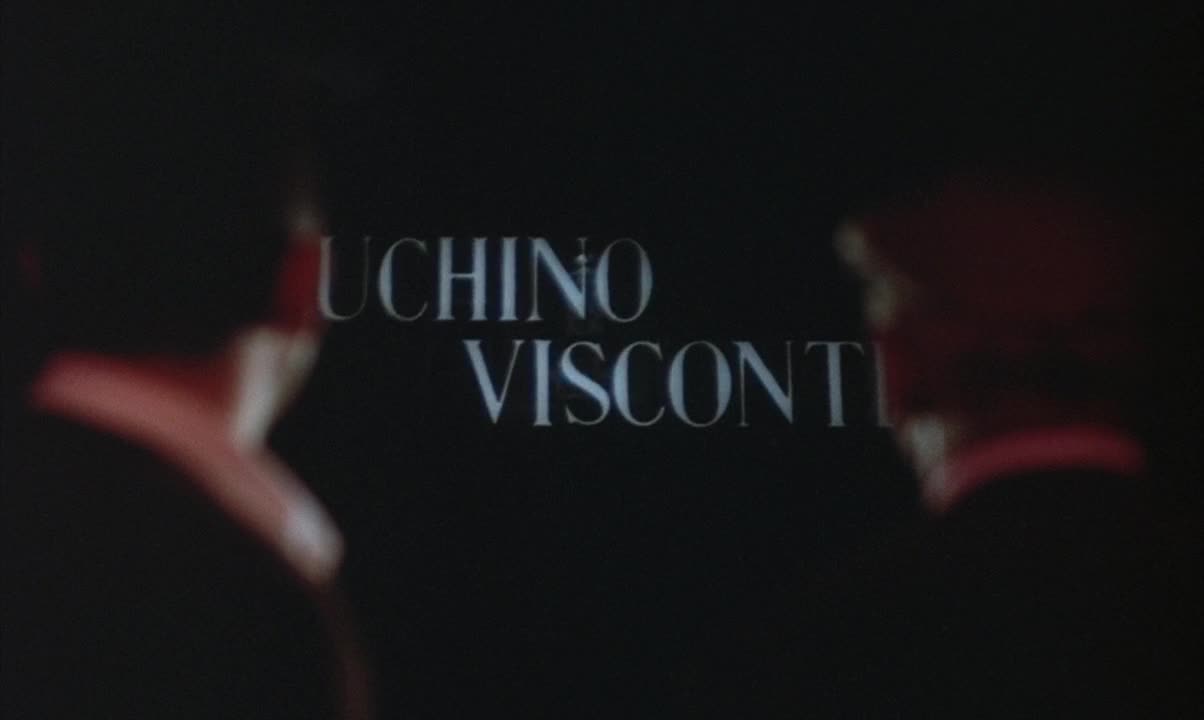 The first film of the double feature night is Luchino Visconti’s La Terra Trema (1948).
The first film of the double feature night is Luchino Visconti’s La Terra Trema (1948).
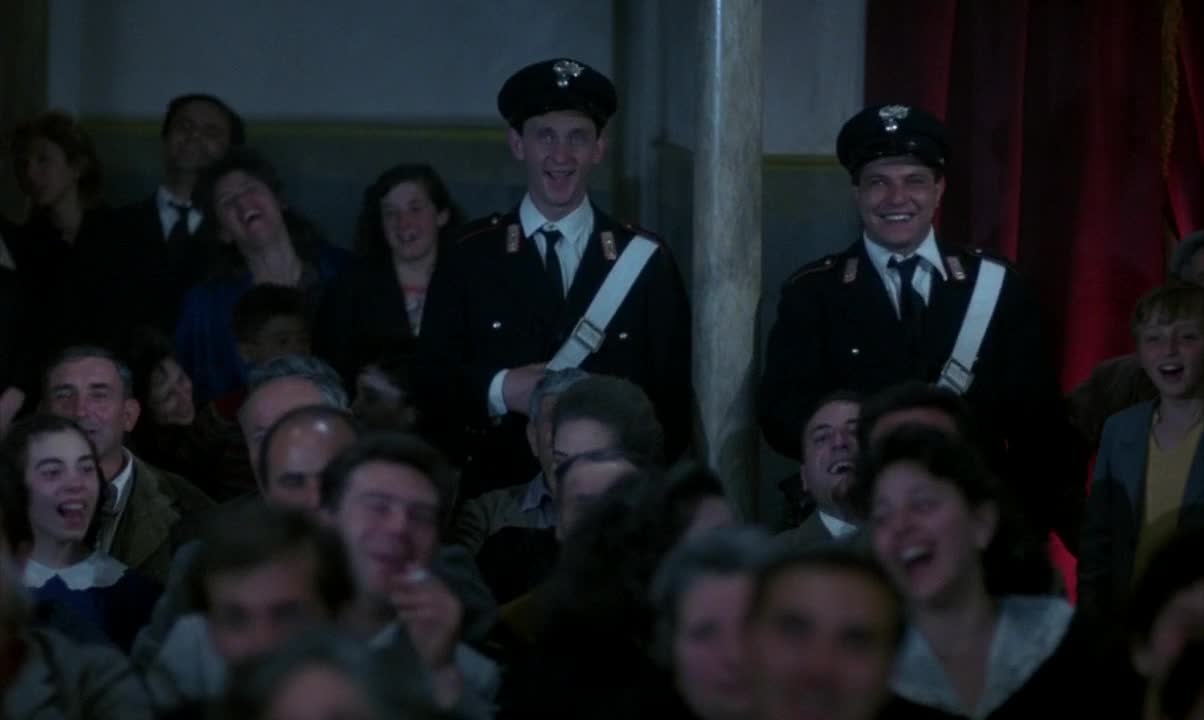
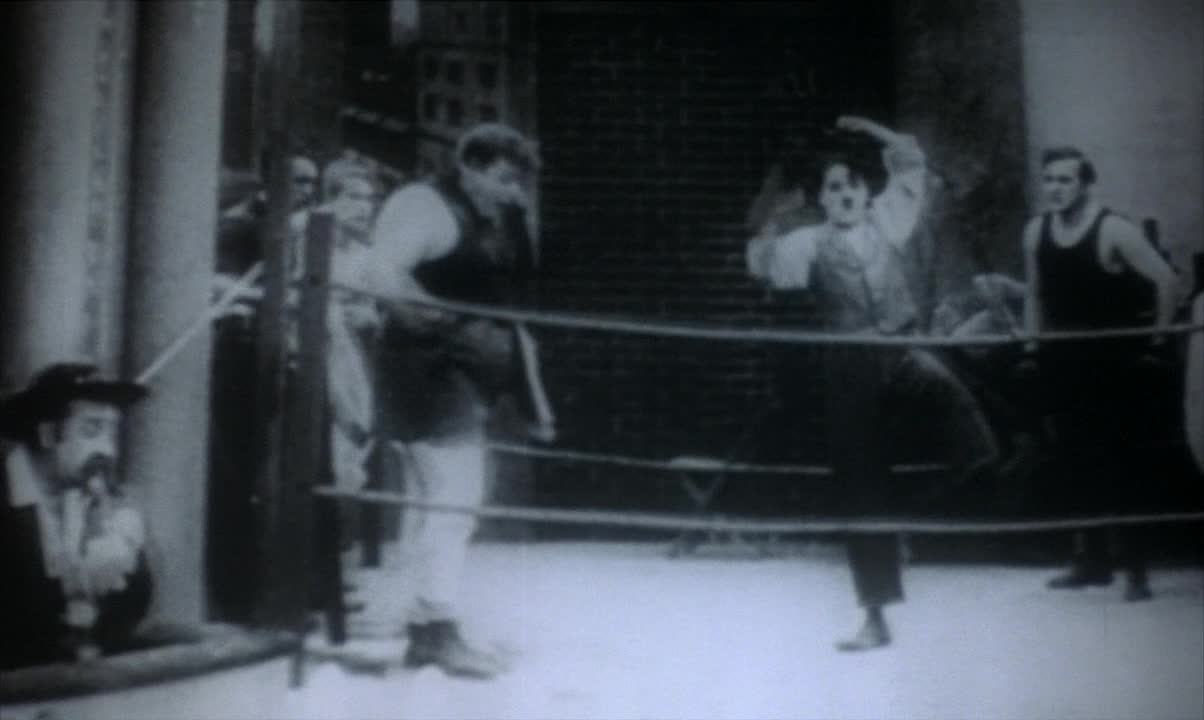
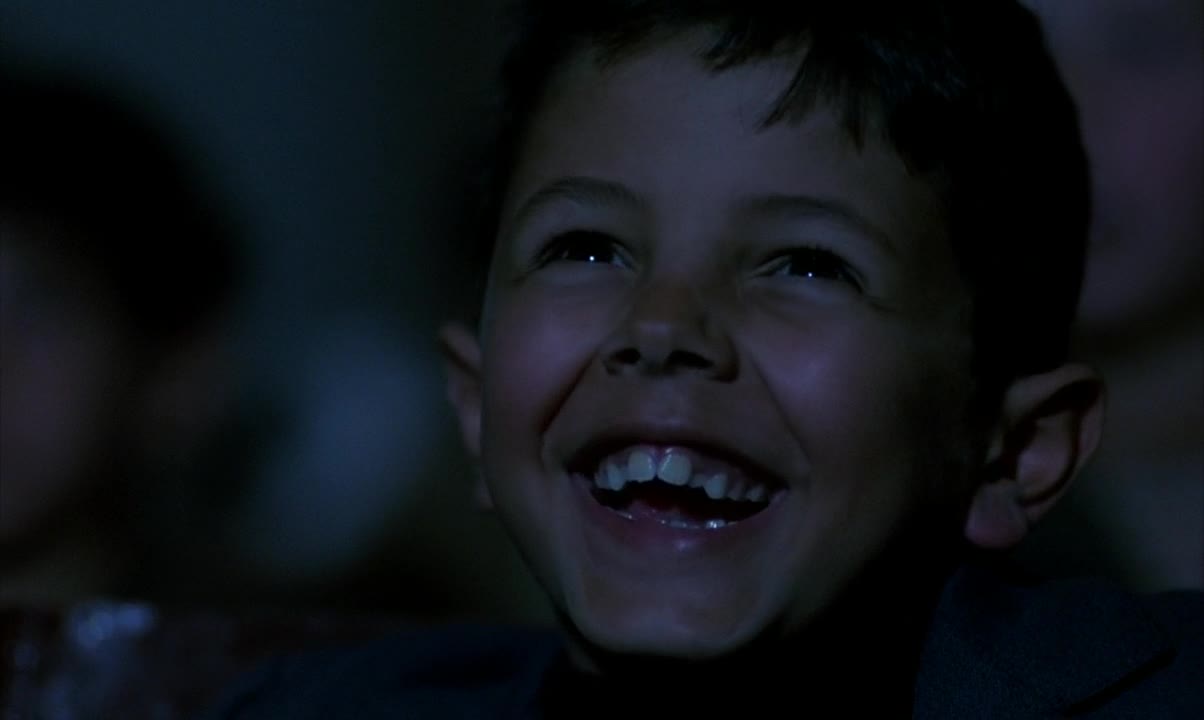 And when the drama ends, here comes the laughter. Mack Sennett’s The Knockout (1914), starring Charles Chaplin and Roscoe “Fatty” Arbuckle.
And when the drama ends, here comes the laughter. Mack Sennett’s The Knockout (1914), starring Charles Chaplin and Roscoe “Fatty” Arbuckle.
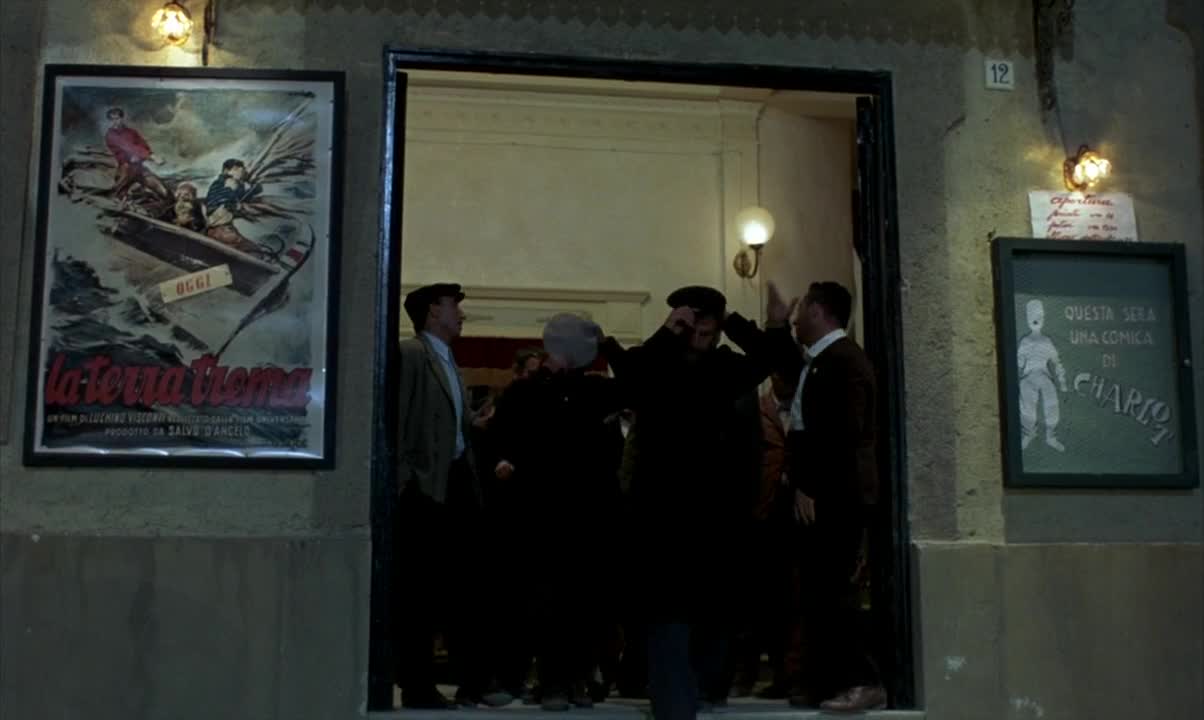 At the cinema’s entrance there are posters for both films. The Knockout is not listed with its title, but as a “comedy by Charlot“.
At the cinema’s entrance there are posters for both films. The Knockout is not listed with its title, but as a “comedy by Charlot“.
 Another night at the cinema for Toto. In this scene,the end credits of Alberto Lattuada’s Il mulino del Po (1949) are visible.
Another night at the cinema for Toto. In this scene,the end credits of Alberto Lattuada’s Il mulino del Po (1949) are visible.
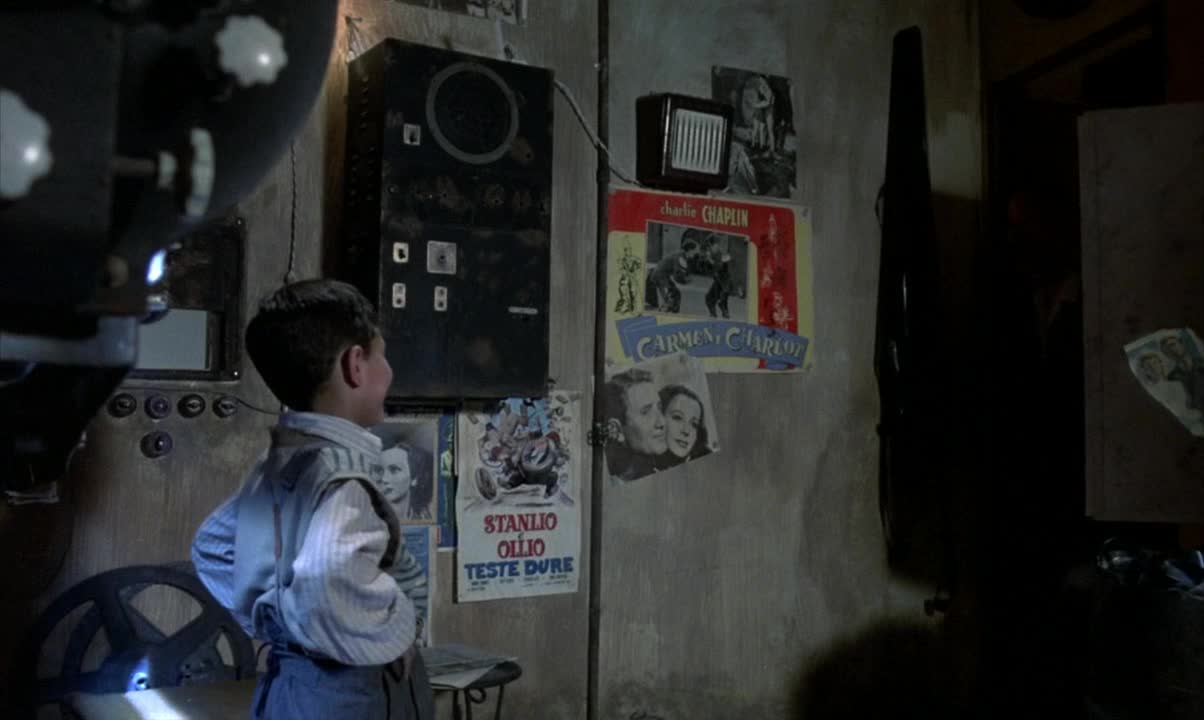 After the end of the film, Toto finds a way to sneak into the projection room again. Posters of John G. Blystone’s Block-Heads (1938), starring Oliver Hardy and Stan Laurel, and Charles Chaplin’s Burlesque on Carmen (1915) can be seen on the walls.
After the end of the film, Toto finds a way to sneak into the projection room again. Posters of John G. Blystone’s Block-Heads (1938), starring Oliver Hardy and Stan Laurel, and Charles Chaplin’s Burlesque on Carmen (1915) can be seen on the walls.
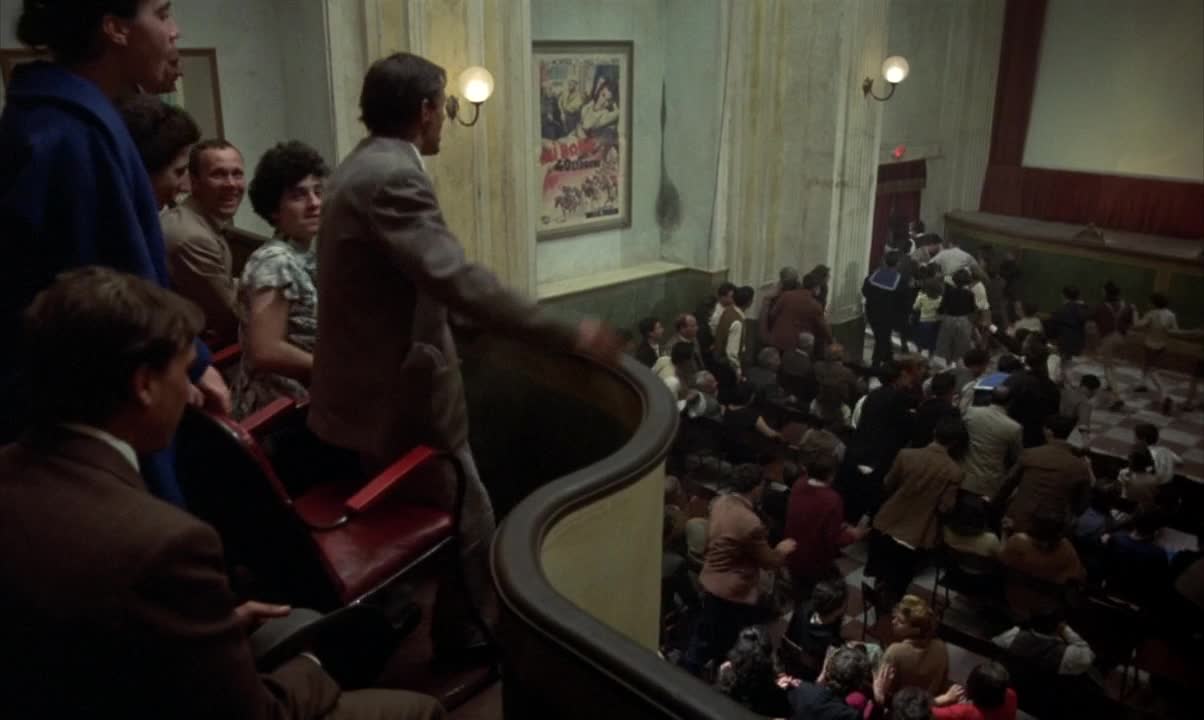 When he’s thrown out of the room, Toto runs to the village’s main square where the big news starts to spread. A Neapolitan who lives in the village wins the lottery. The news reaches the cinema and the screening stops. A poster of Arthur Lubin’s Ali Baba and the Forty Thieves (1944) is visible on the wall.
When he’s thrown out of the room, Toto runs to the village’s main square where the big news starts to spread. A Neapolitan who lives in the village wins the lottery. The news reaches the cinema and the screening stops. A poster of Arthur Lubin’s Ali Baba and the Forty Thieves (1944) is visible on the wall.
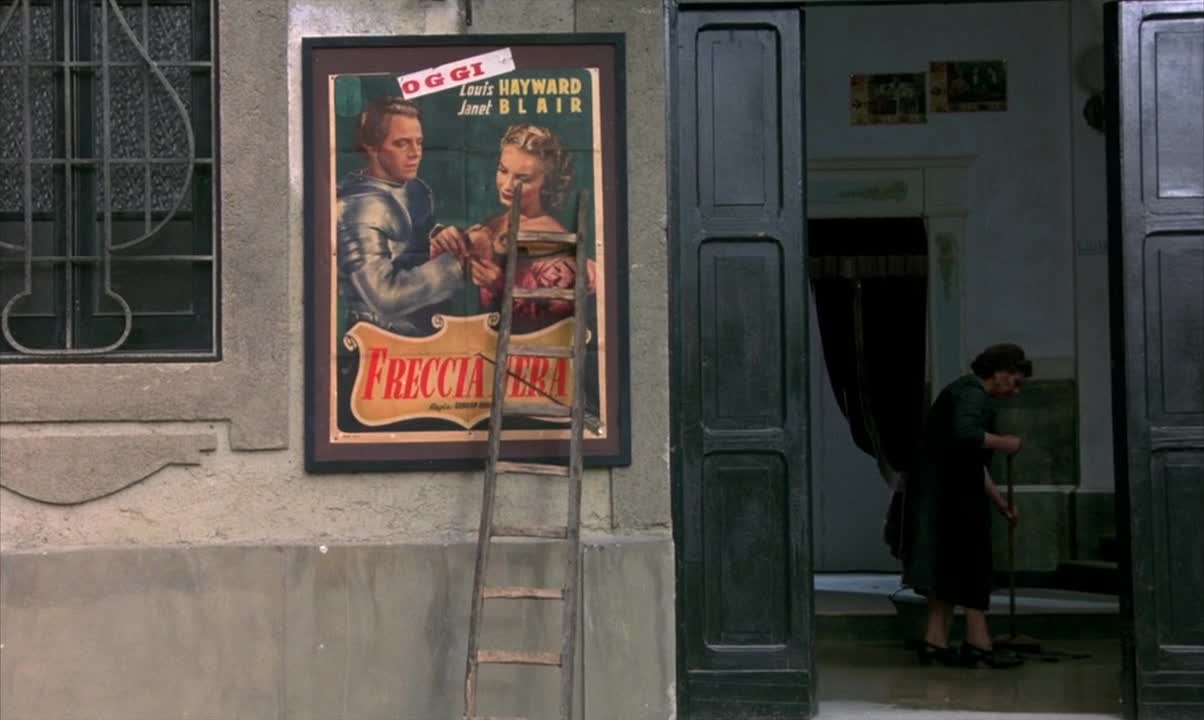 Next, a sequence of everyday village life. A poster of Gordon Douglas’ The Black Arrow (1948) is visible.
Next, a sequence of everyday village life. A poster of Gordon Douglas’ The Black Arrow (1948) is visible.
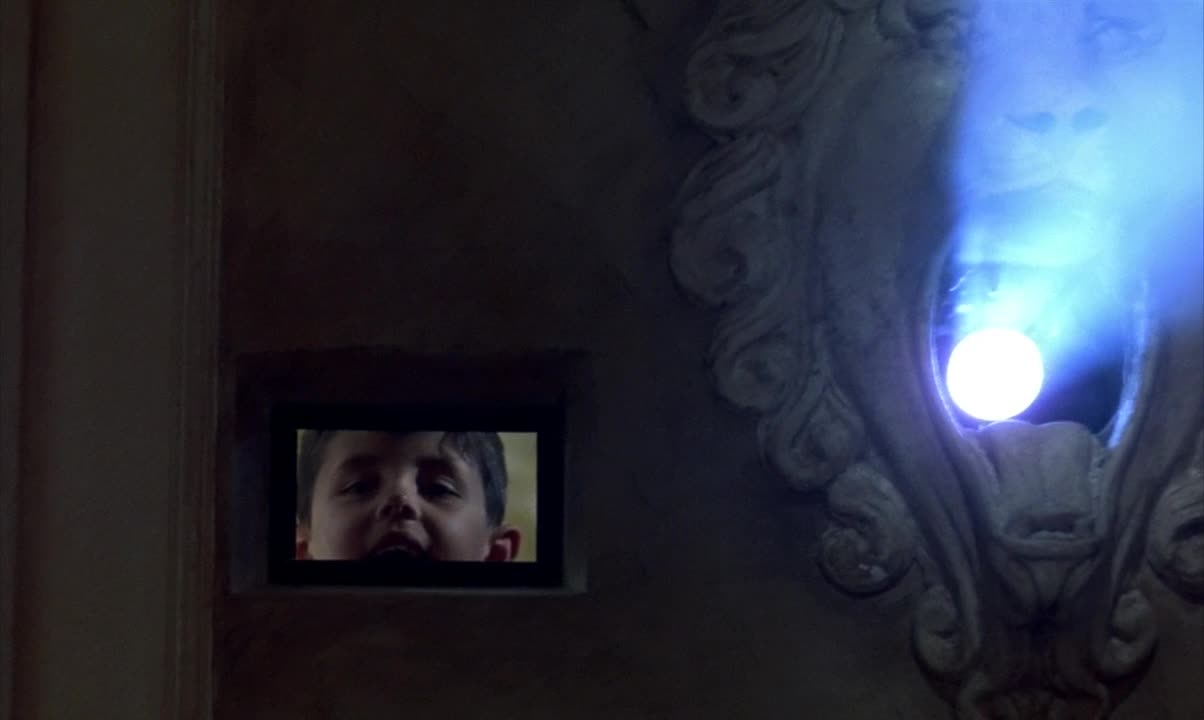 After school examinations, where Toto helps Alfredo, the little boy’s dream comes true. He is allowed in the projection room, as Alfredo’s assistant.
After school examinations, where Toto helps Alfredo, the little boy’s dream comes true. He is allowed in the projection room, as Alfredo’s assistant.
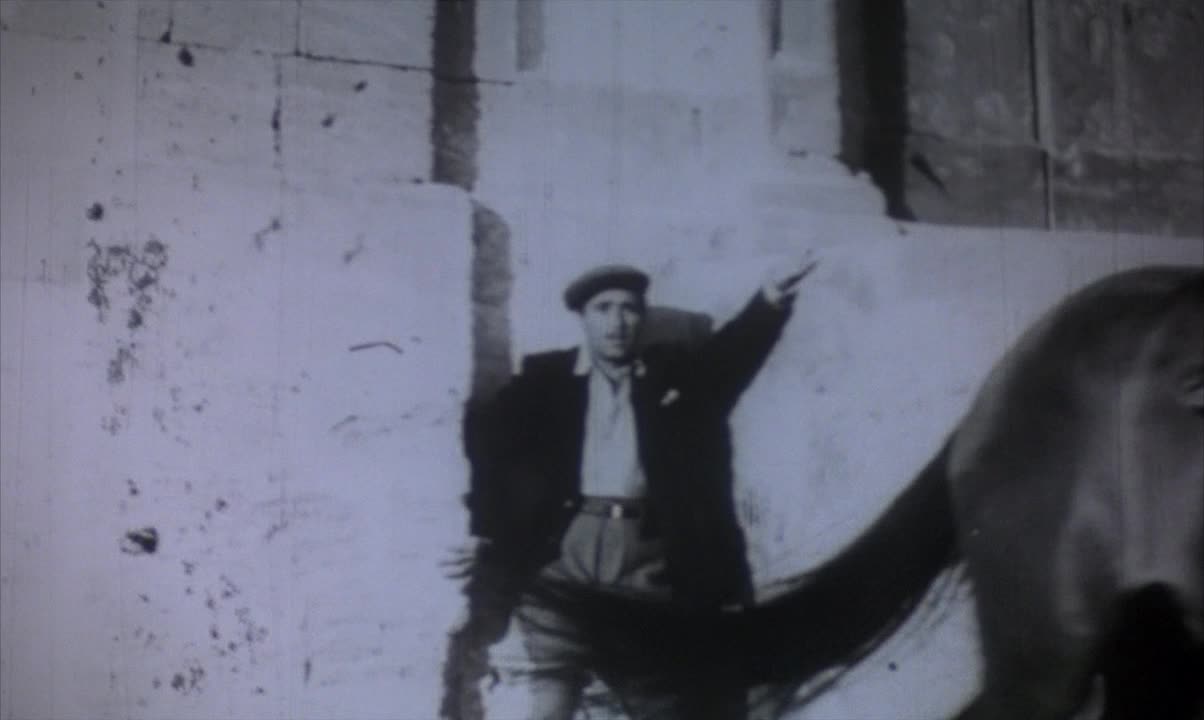 The first film for which the boy runs the projector is Pietro Germi’s In nome della legge (1949).
The first film for which the boy runs the projector is Pietro Germi’s In nome della legge (1949).
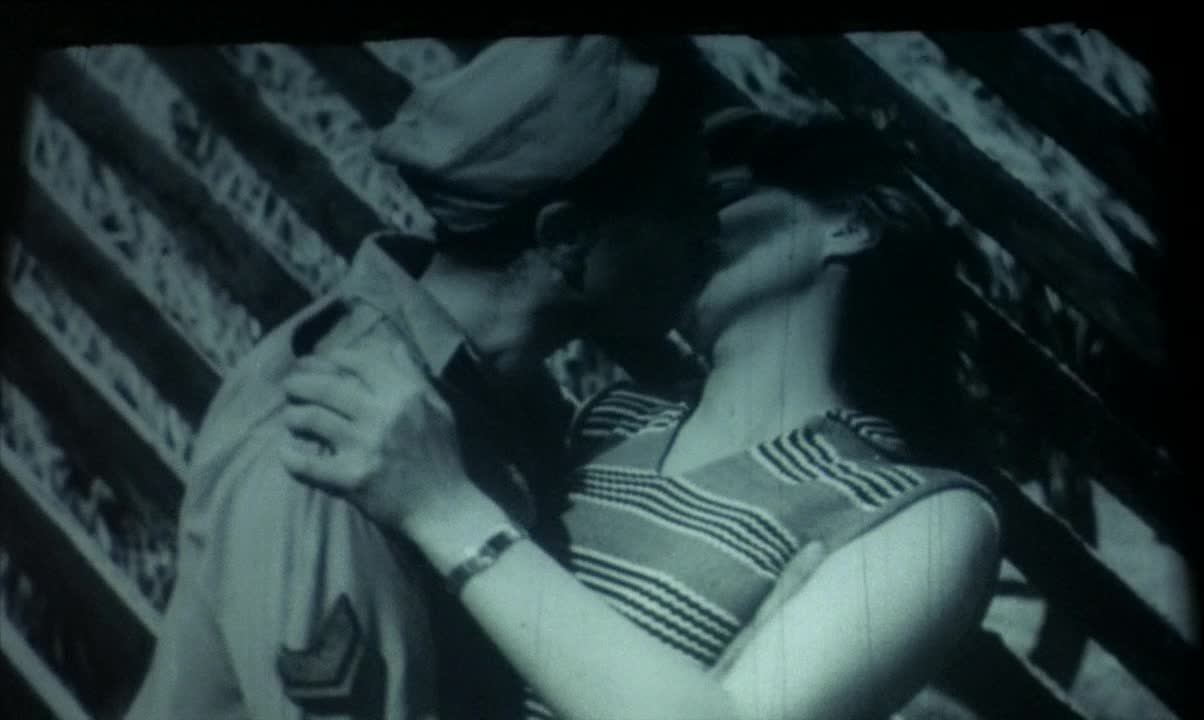
 And Father Adelfio’s censor bell is still ringing. A kiss from Giuseppe De Santis’ Riso Amaro (1949).
And Father Adelfio’s censor bell is still ringing. A kiss from Giuseppe De Santis’ Riso Amaro (1949).
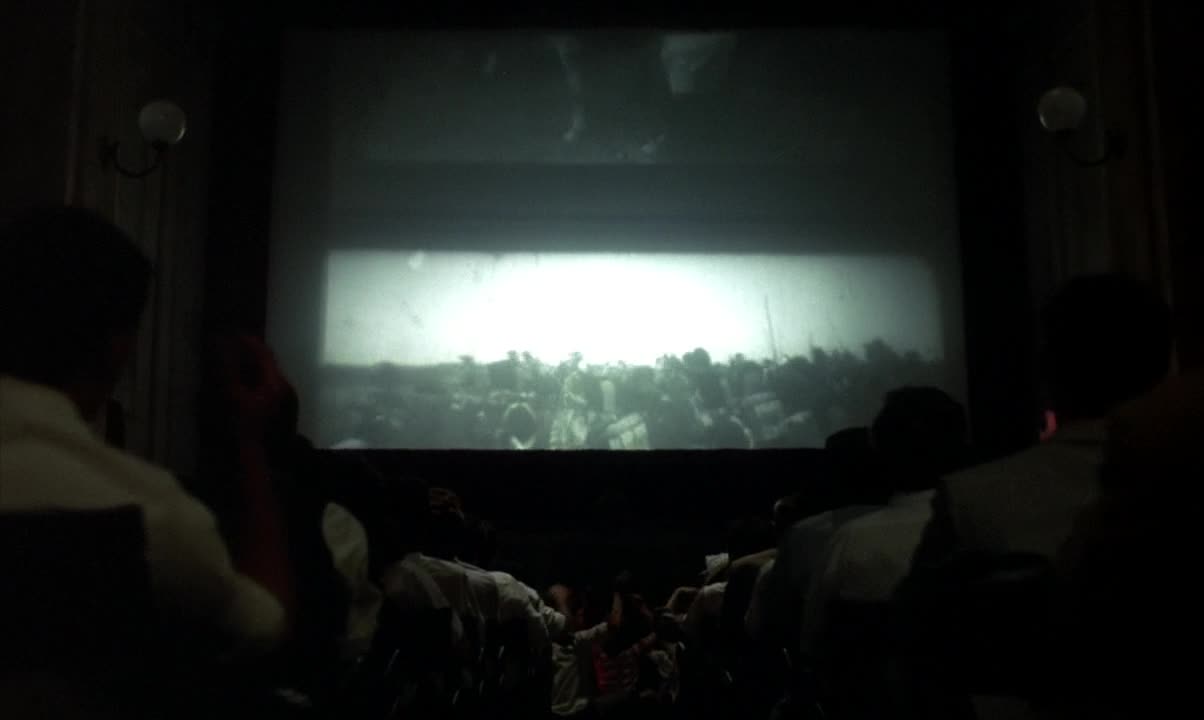 There will be some mistakes during the learning process. Mario Camerini’s La Figlia del Capitano (1947).
There will be some mistakes during the learning process. Mario Camerini’s La Figlia del Capitano (1947).
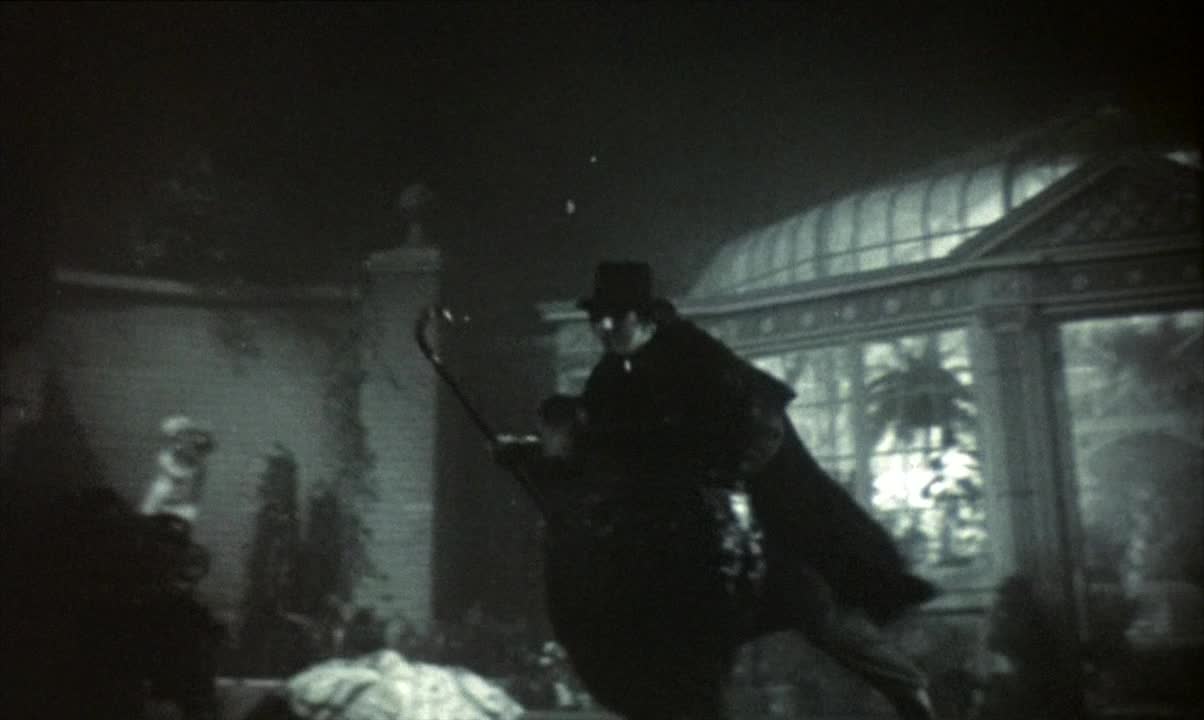 The sequence is continued with Victor Fleming’s Dr. Jekyll and Mr. Hyde (1941) …
The sequence is continued with Victor Fleming’s Dr. Jekyll and Mr. Hyde (1941) …
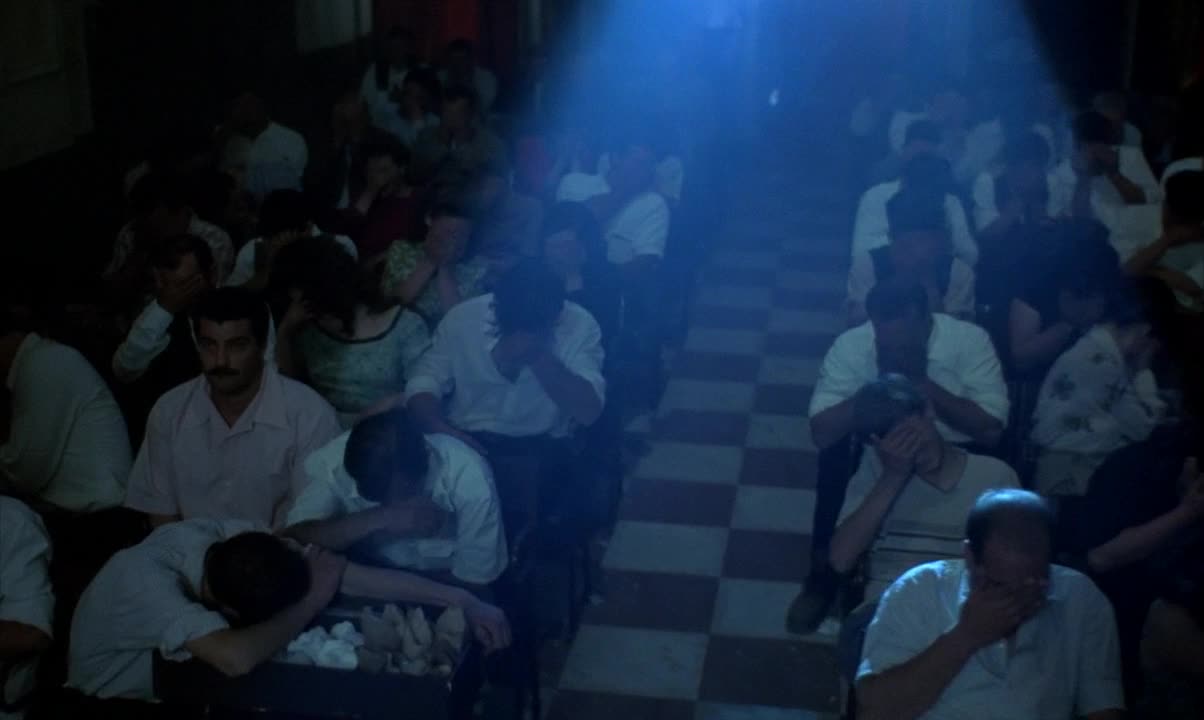 … which frightens most of the viewers.
… which frightens most of the viewers.
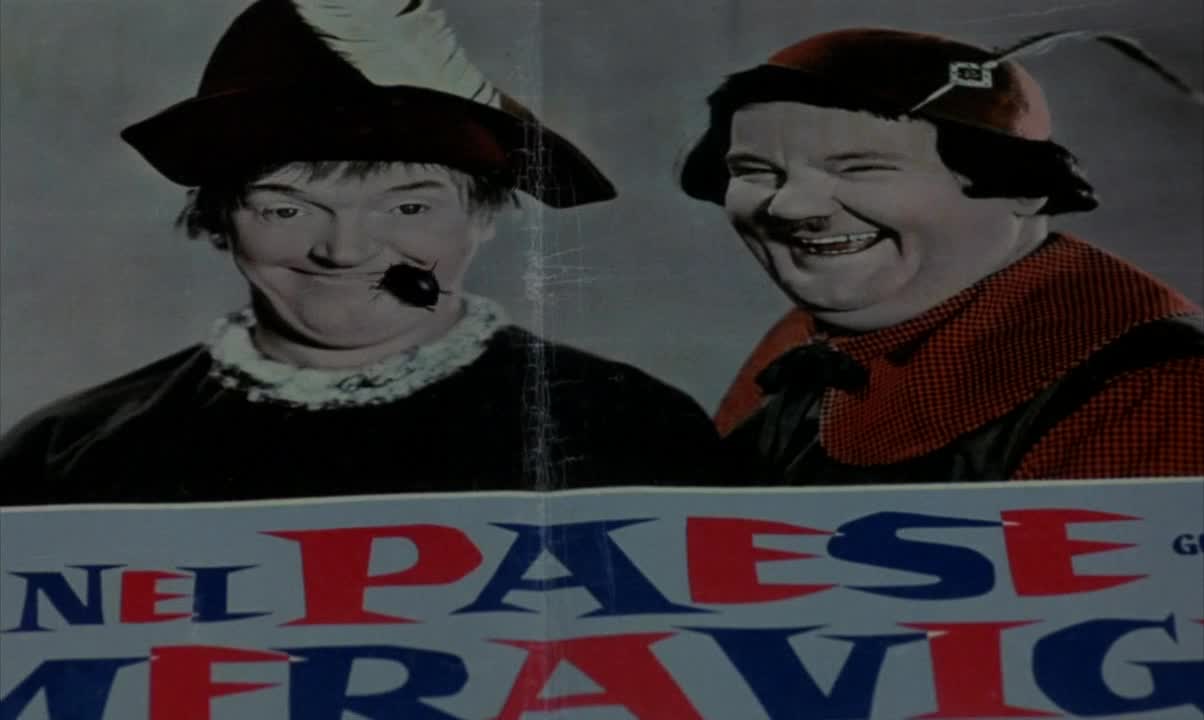 A little bug is crawling on the poster of the Laurel-Hardy comedy, Babes in Toyland (1934, directed by Gus Meins & Charley Rogers) …
A little bug is crawling on the poster of the Laurel-Hardy comedy, Babes in Toyland (1934, directed by Gus Meins & Charley Rogers) …
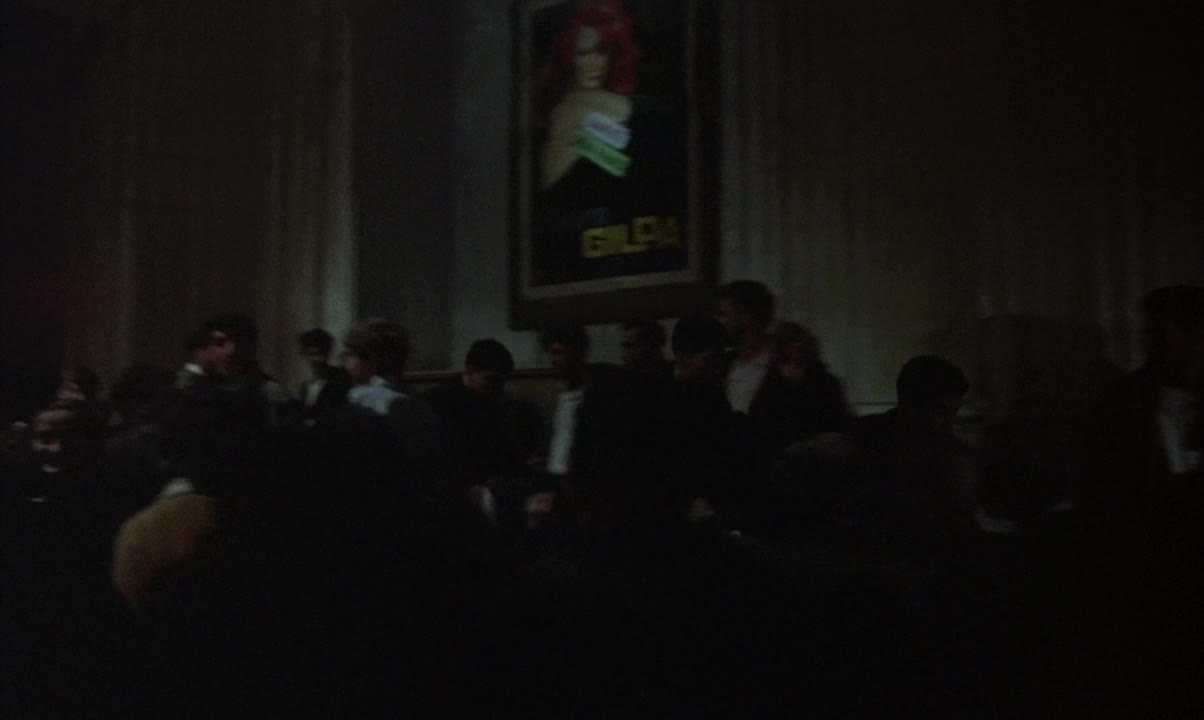 … and before it ends up in the mouth of a frequently sleeping viewer, a poster of Charles Vidor’s Gilda (1946) is visible.
… and before it ends up in the mouth of a frequently sleeping viewer, a poster of Charles Vidor’s Gilda (1946) is visible.
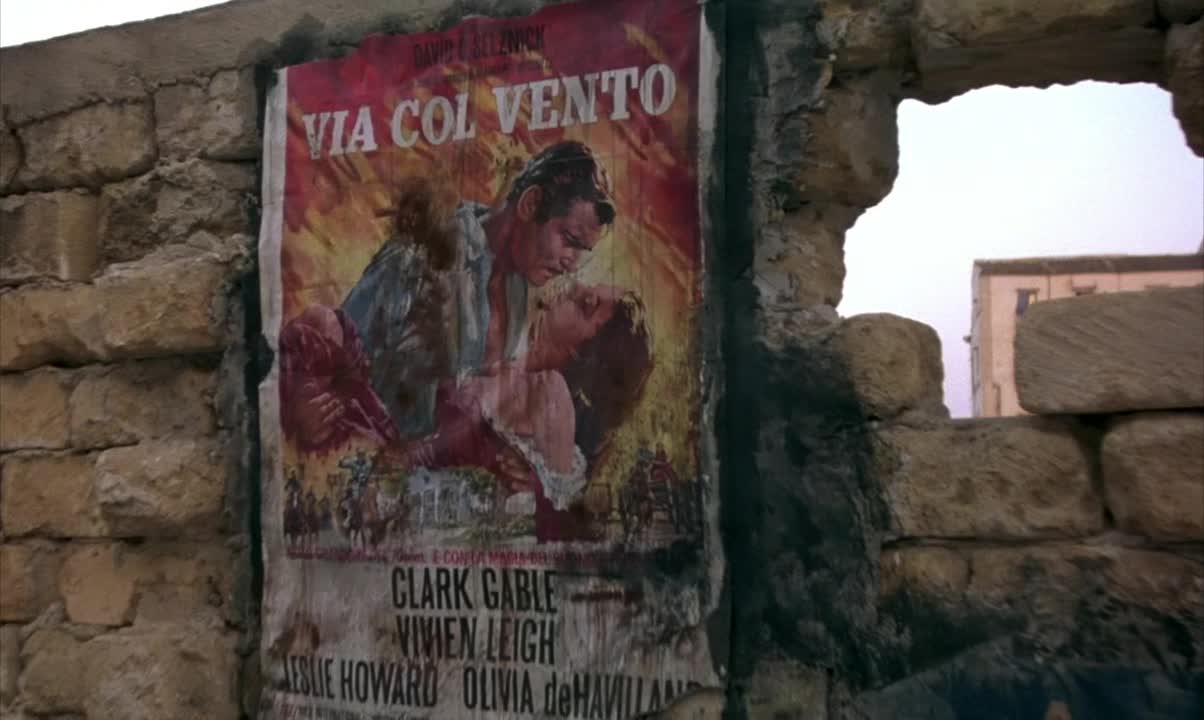
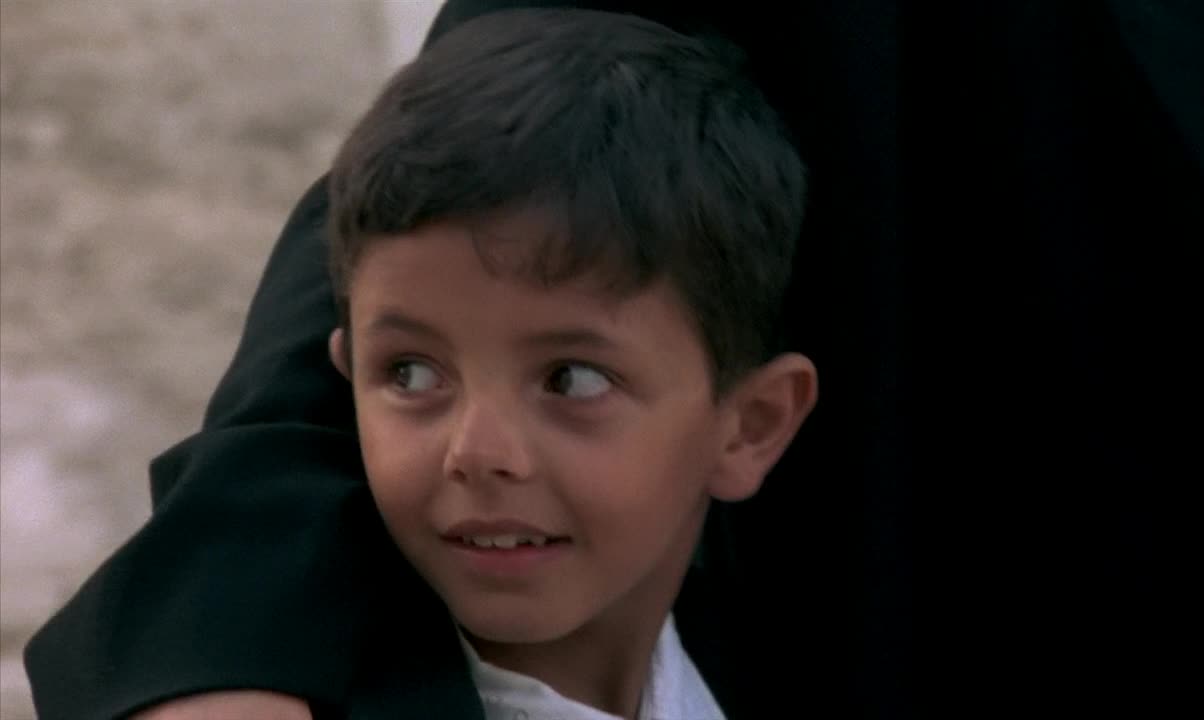 Back to real life, and to the day that Toto and his mother are officialy informed about his father’s death at war. Toto forgets his grief while looking at an old poster of Victor Fleming’s Gone With the Wind (1939).
Back to real life, and to the day that Toto and his mother are officialy informed about his father’s death at war. Toto forgets his grief while looking at an old poster of Victor Fleming’s Gone With the Wind (1939).
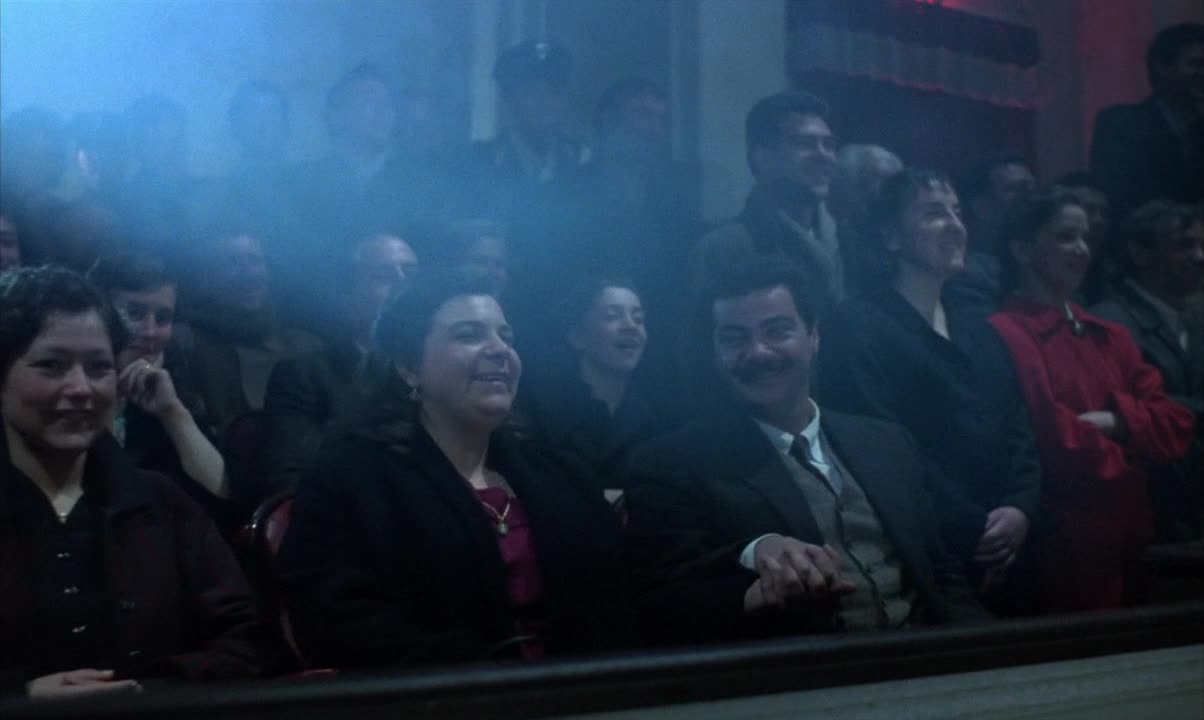 The tragic night when Cinema Paradiso catches fire, starts with lots of laughs and excitement…
The tragic night when Cinema Paradiso catches fire, starts with lots of laughs and excitement…
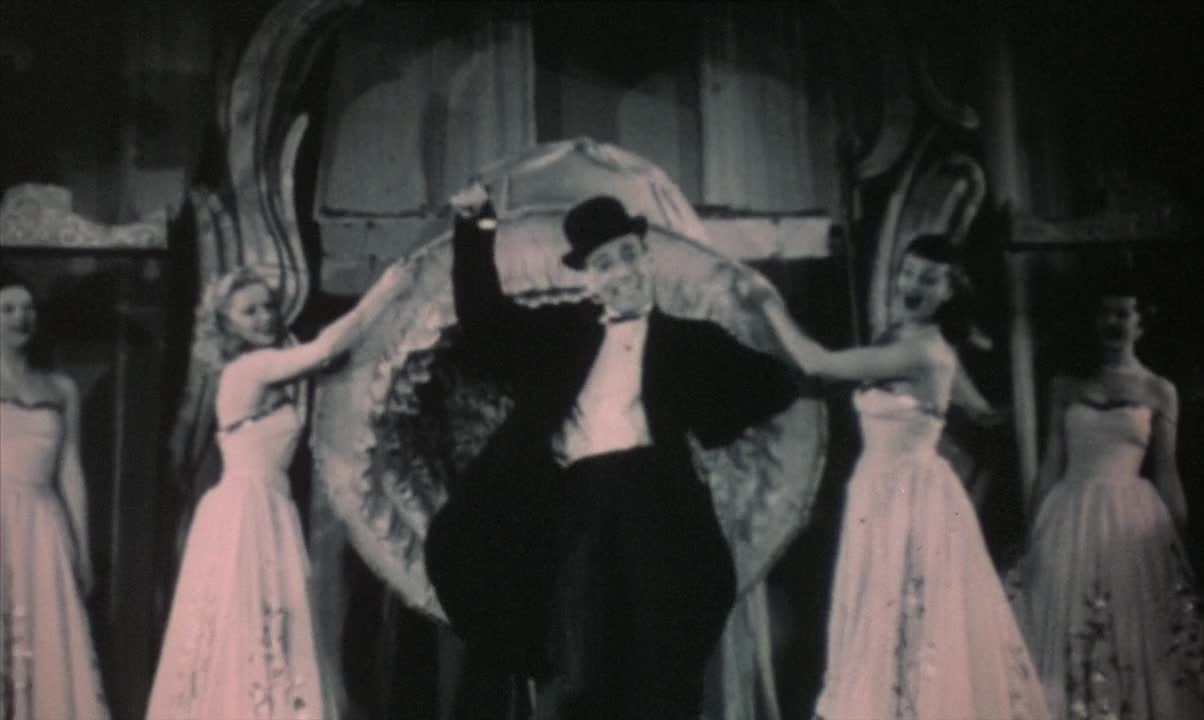 … brought on by the performance of the Italian comedian Totò in Mario Mattoli’s I pompieri di Viggiù (1949).
… brought on by the performance of the Italian comedian Totò in Mario Mattoli’s I pompieri di Viggiù (1949).
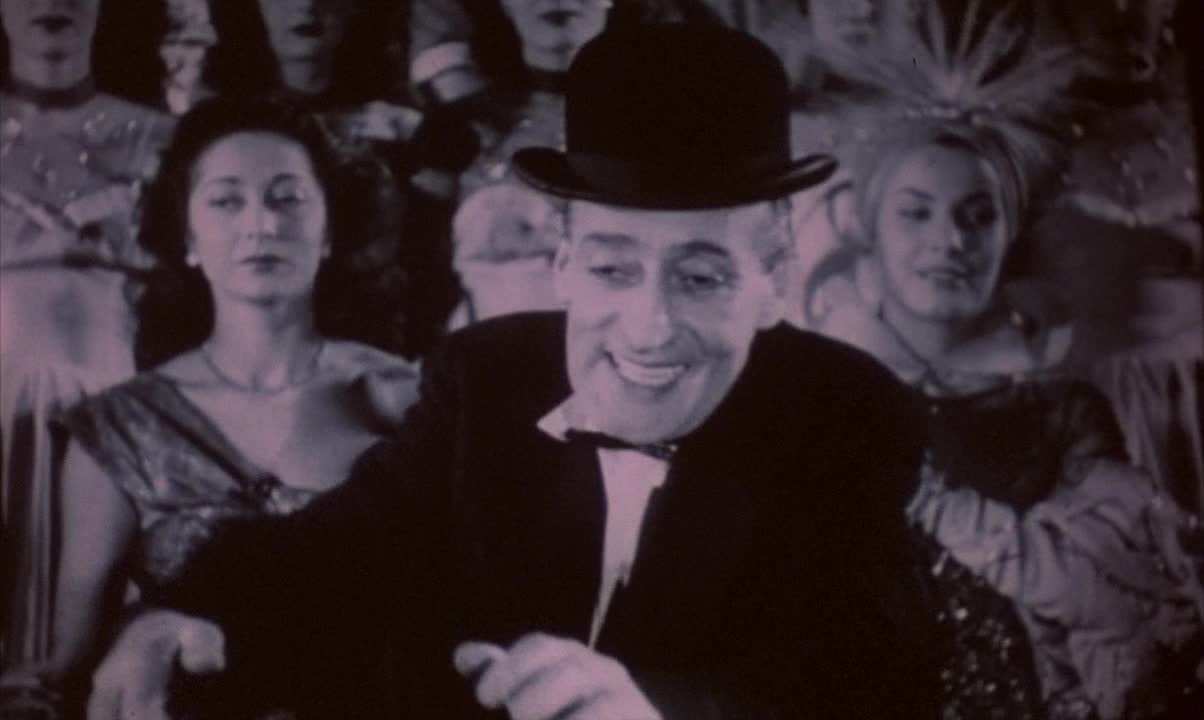 … and the laughter is so loud that the people outside the cinema demand to go inside.
… and the laughter is so loud that the people outside the cinema demand to go inside.
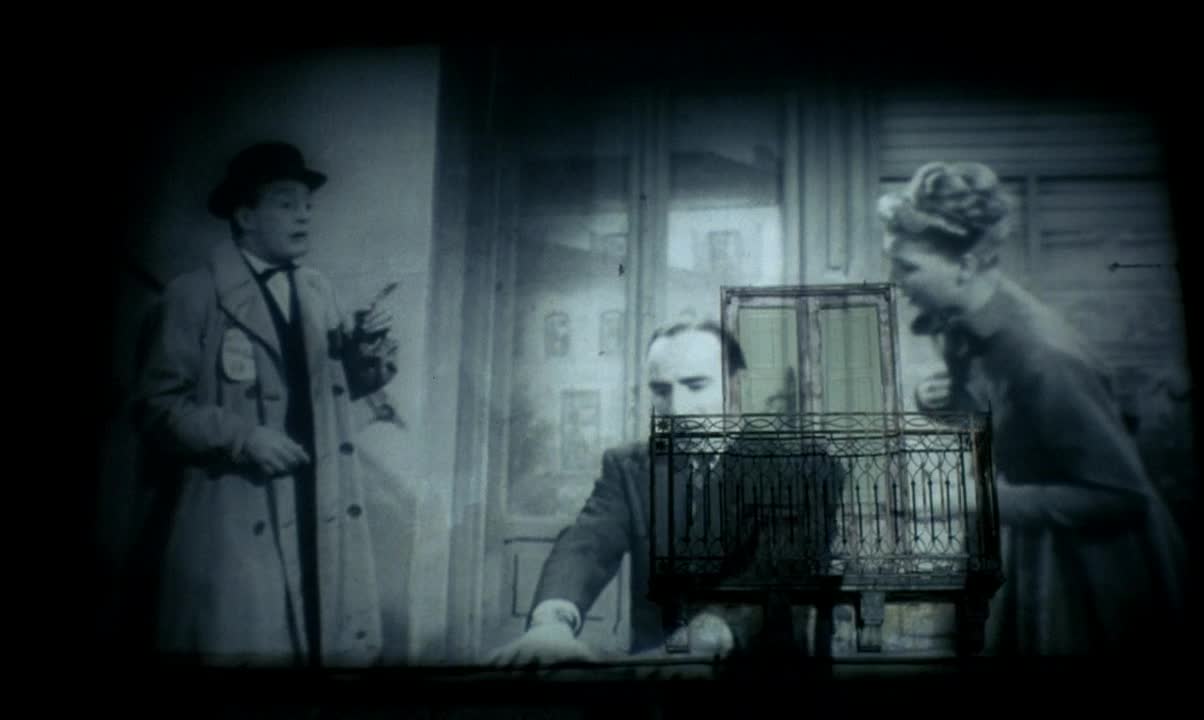
 But this is impossible, so Alfredo makes his magic tricks and creates a second screen outside the building, on the walls of main square. The last beautiful moment before the fire.
But this is impossible, so Alfredo makes his magic tricks and creates a second screen outside the building, on the walls of main square. The last beautiful moment before the fire.
 The beginning of a new era. Goodbye Cinema Paradiso, welcome Nuovo Cinema Paradiso.
The beginning of a new era. Goodbye Cinema Paradiso, welcome Nuovo Cinema Paradiso.
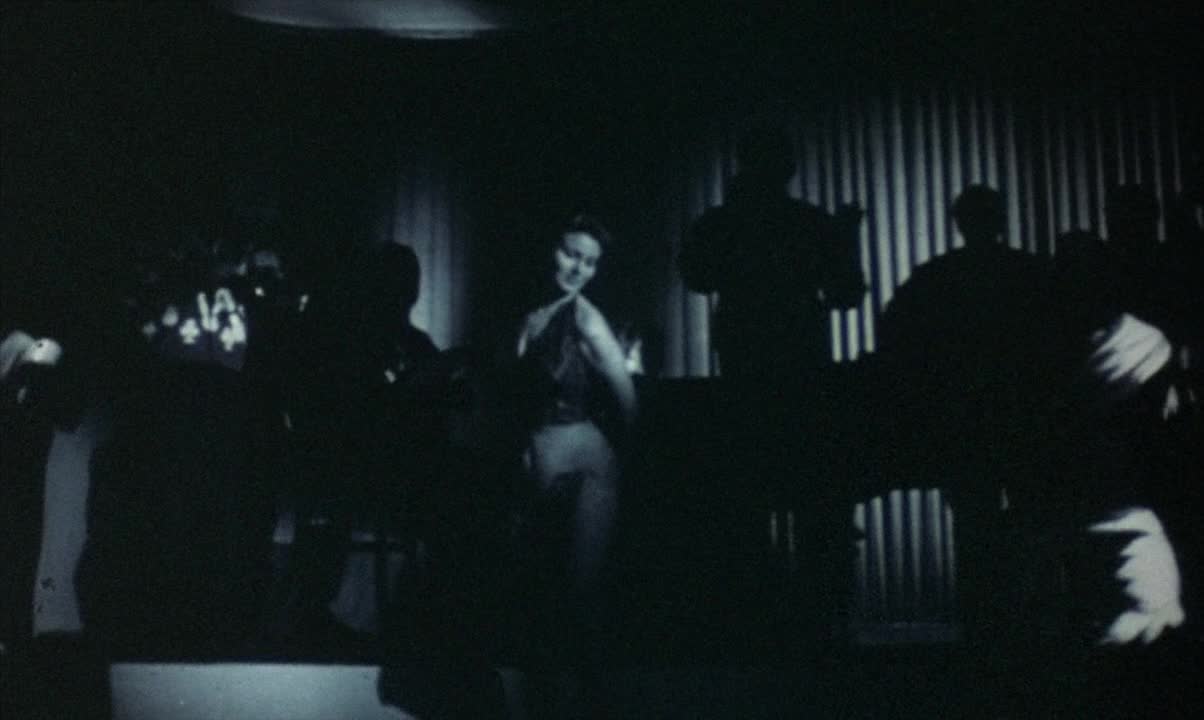 … for Silvana Mangano’s exotic dance moves. The film is Alberto Lattuada’s Anna (1951) …
… for Silvana Mangano’s exotic dance moves. The film is Alberto Lattuada’s Anna (1951) …
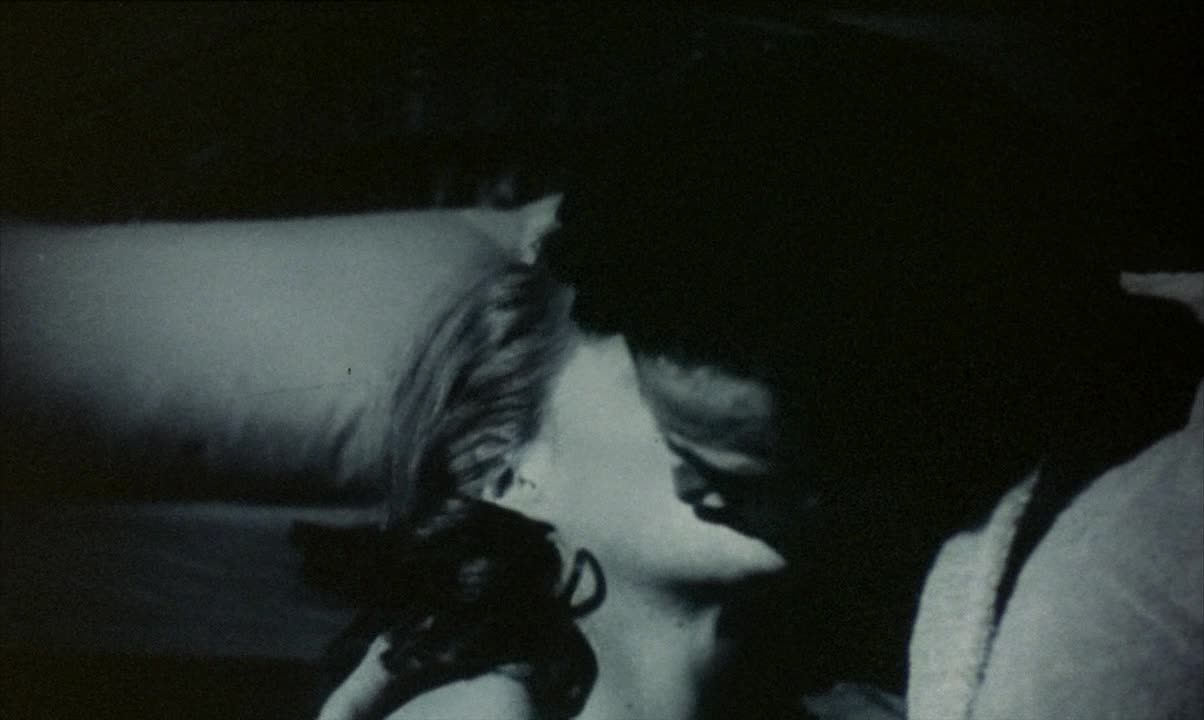
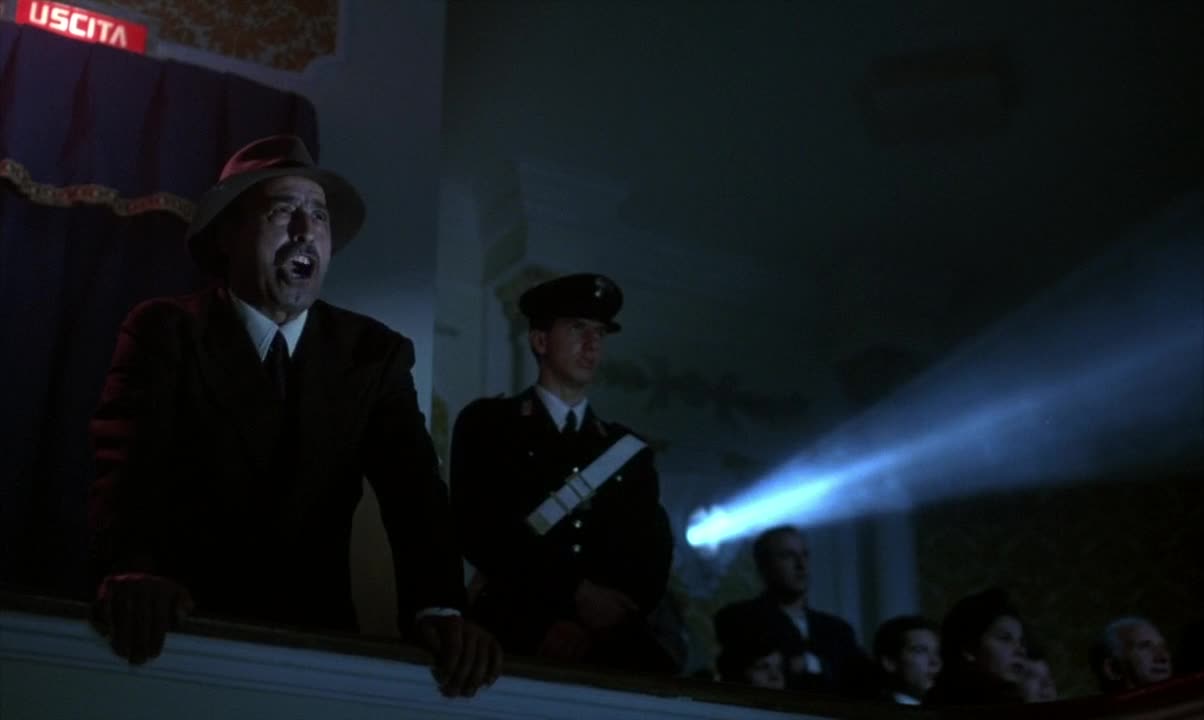 … uncensored! Its kissing scene is widely welcomed by the viewers.
… uncensored! Its kissing scene is widely welcomed by the viewers.
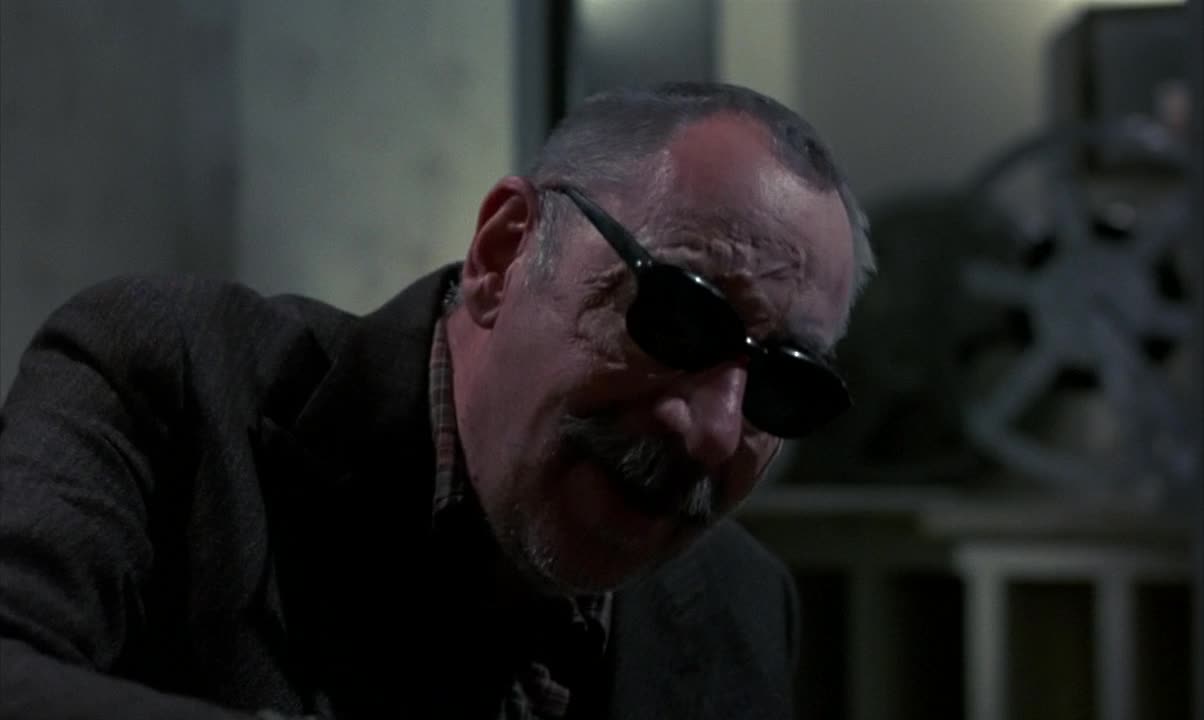 During the next few years, Toto runs the projector while the blind Alfredo keeps him company. The little boy becomes a young man, Salvatore, who’s still surprised by Alfredo’s tricks, like the one above in Vittorio De Sica’s L’oro di Napoli (1954). Even without his vision, Alfredo realises that the film is out of focus.
During the next few years, Toto runs the projector while the blind Alfredo keeps him company. The little boy becomes a young man, Salvatore, who’s still surprised by Alfredo’s tricks, like the one above in Vittorio De Sica’s L’oro di Napoli (1954). Even without his vision, Alfredo realises that the film is out of focus.
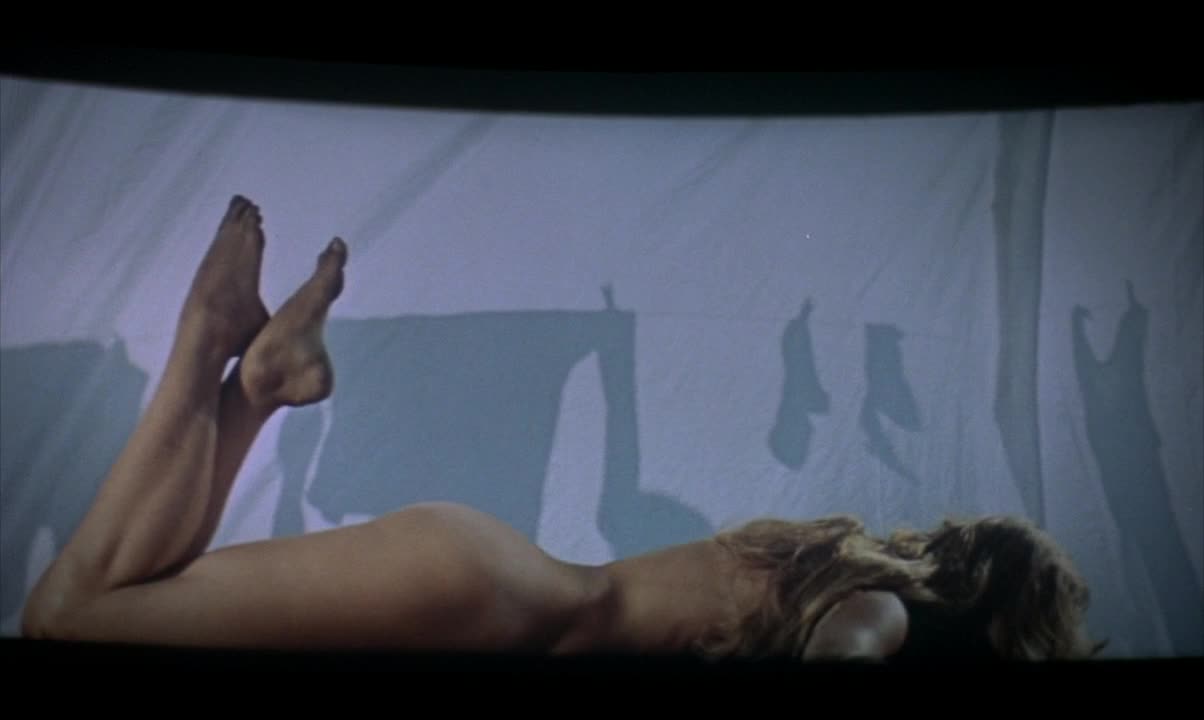 It’s time for the first color film…
It’s time for the first color film…
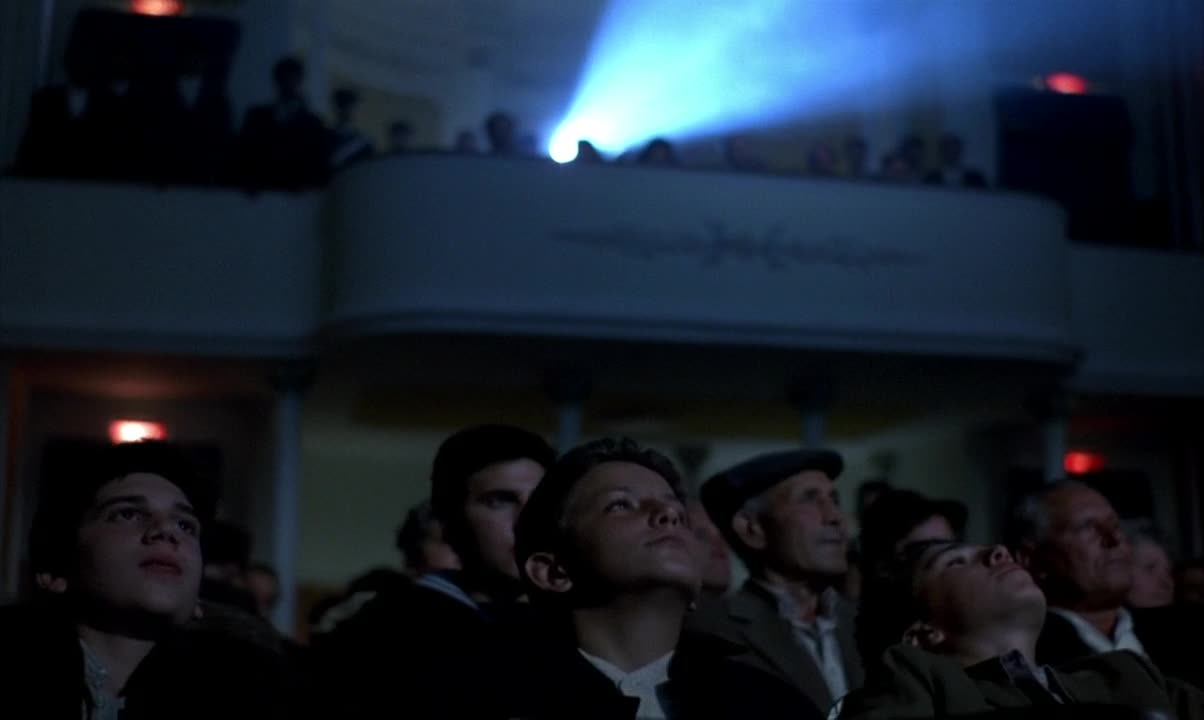 … but the young viewers are interested mostly in Brigitte Bardot’s naked body …
… but the young viewers are interested mostly in Brigitte Bardot’s naked body …
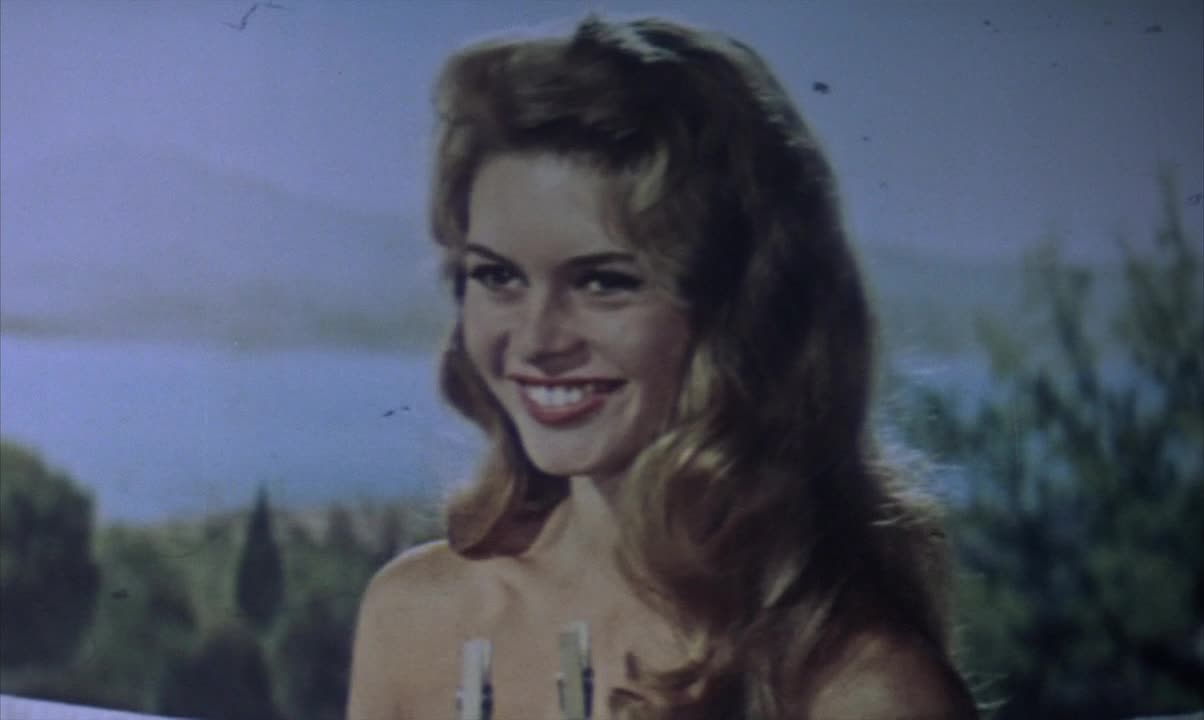 … from Roger Vadim’s Et Dieu… créa la femme (1956).
… from Roger Vadim’s Et Dieu… créa la femme (1956).
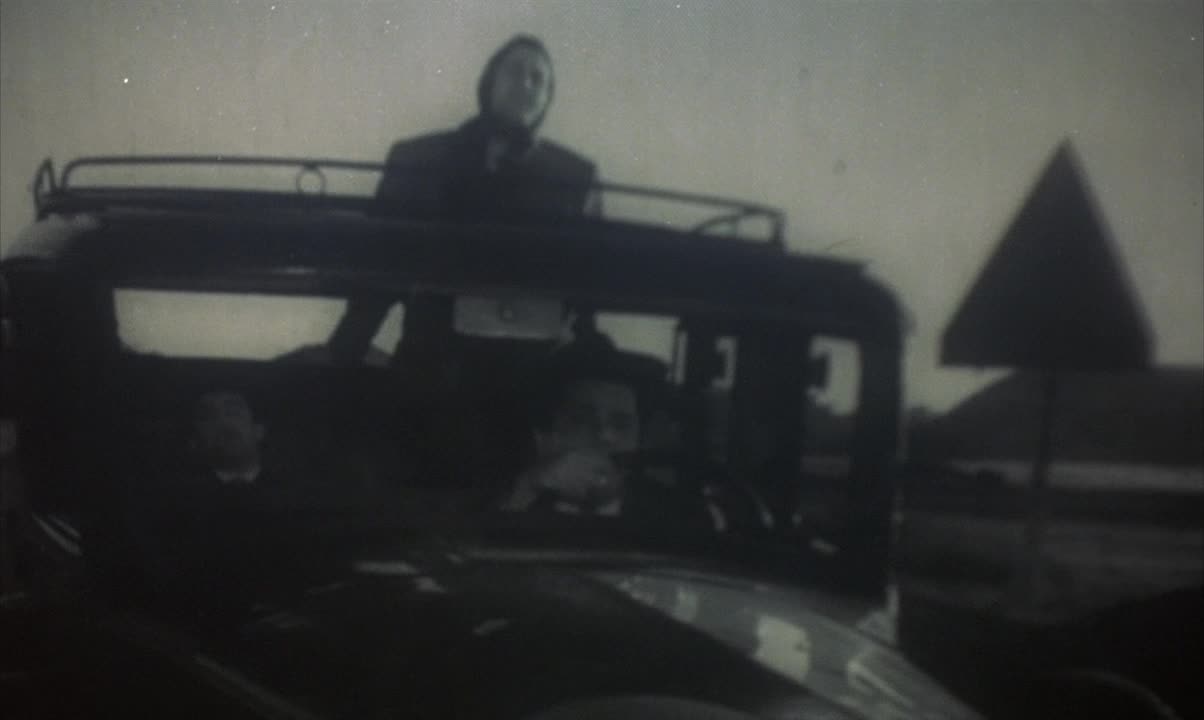 Next, the camera rotates between the scenes of Federico Fellini’s I Vitelloni (1953) and the crowd.
Next, the camera rotates between the scenes of Federico Fellini’s I Vitelloni (1953) and the crowd.
 Preparation for a tear jerker, Raffaello Matarazzo’s Catene (1949).
Preparation for a tear jerker, Raffaello Matarazzo’s Catene (1949).
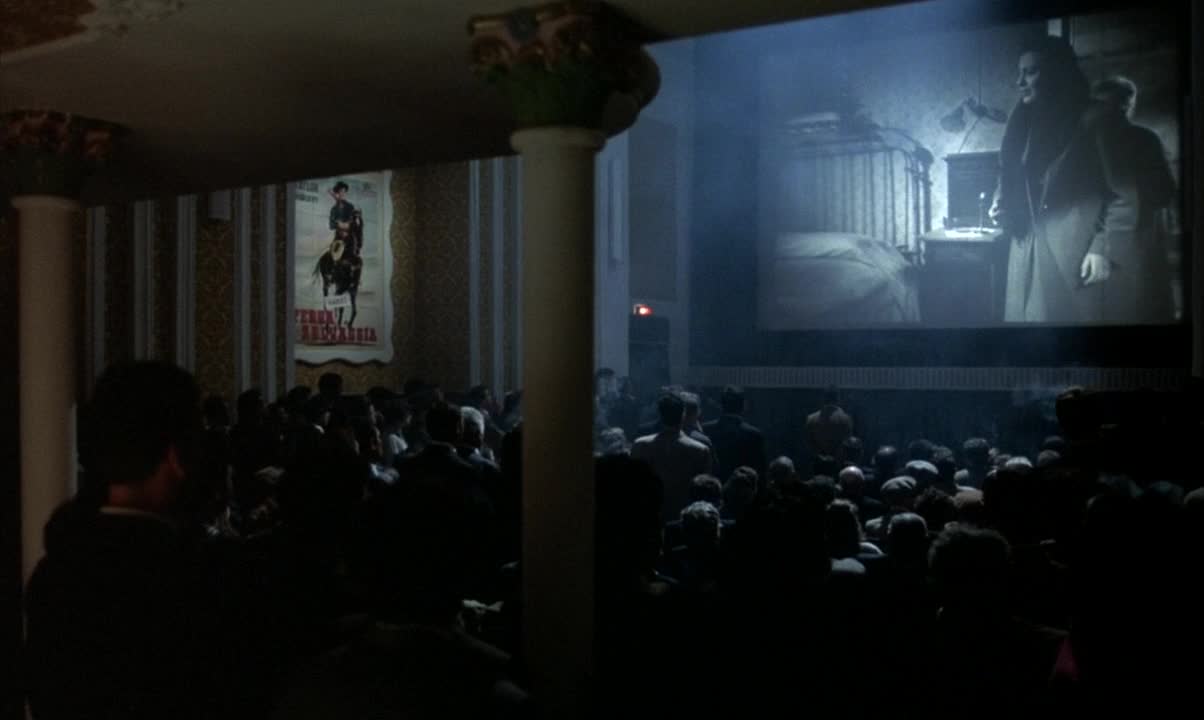 During Catene’s screening, on the left, there is a poster of David Miller’s Billy the Kid (1941), aka Terra Selvaggia.
During Catene’s screening, on the left, there is a poster of David Miller’s Billy the Kid (1941), aka Terra Selvaggia.
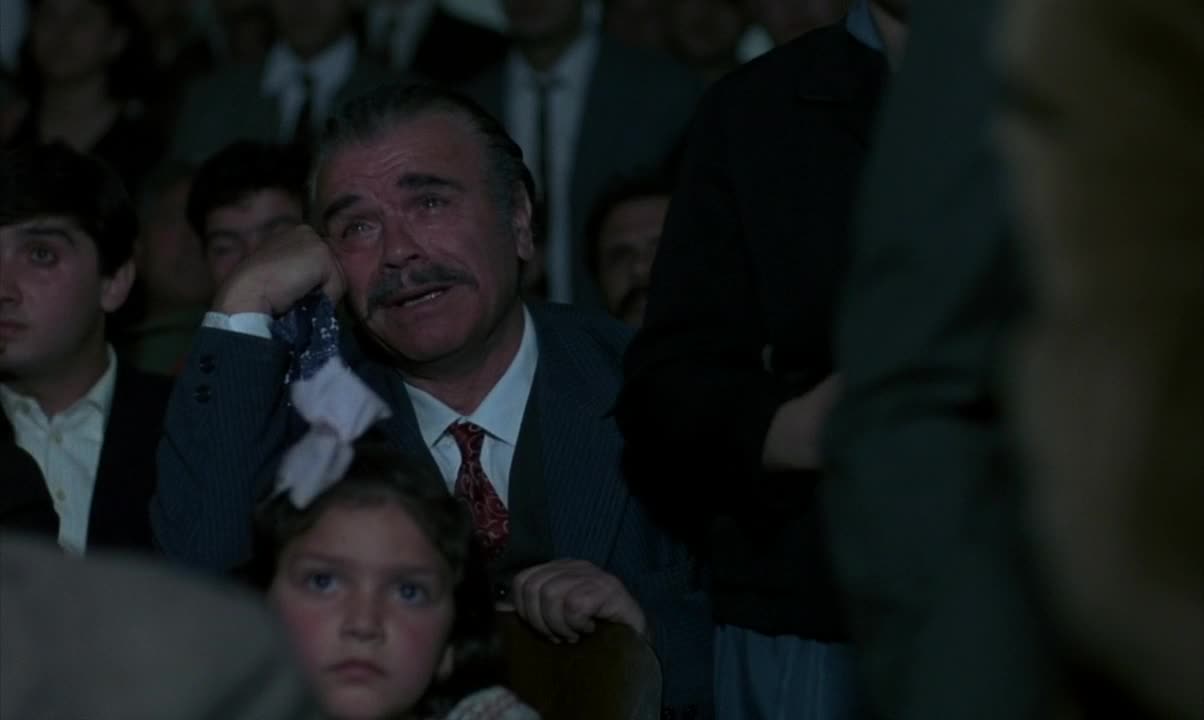 Catene is a huge success – everyone’s crying.
Catene is a huge success – everyone’s crying.
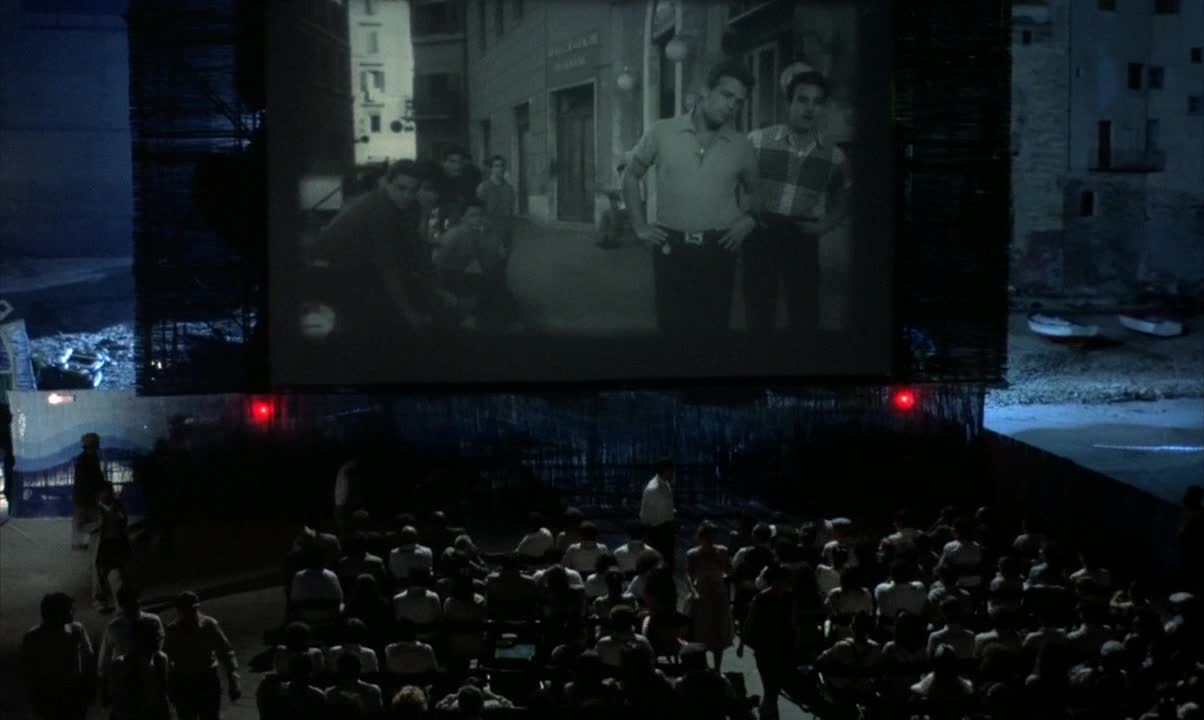 During the summer, Nuovo Cinema Paradiso moves close to the sea. The first film shown is Valerio Zurlini’s Le ragazze di San Frediano (1955).
During the summer, Nuovo Cinema Paradiso moves close to the sea. The first film shown is Valerio Zurlini’s Le ragazze di San Frediano (1955).
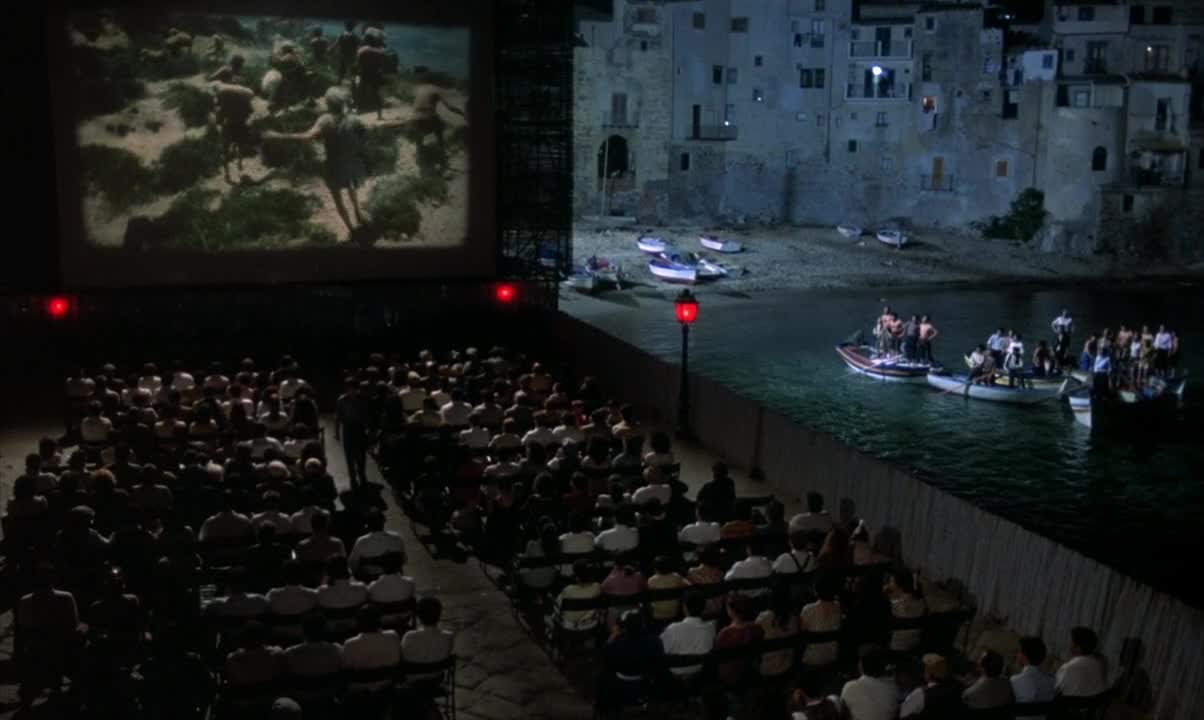
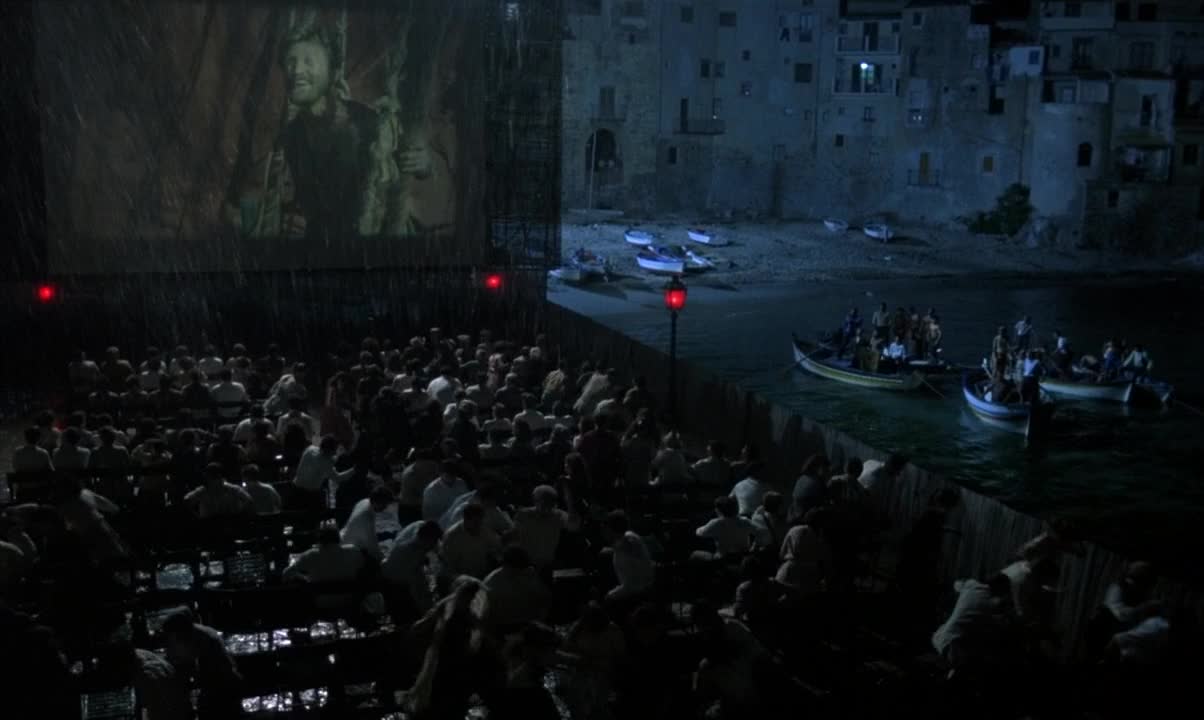 Followed by Mario Camerini’s Ulisse (1954), the last reference from Salvatore’s recollection of his childhood. Almost 30 years later he returns as a well known film director to attend Alfredo’s funeral. Returning to Rome he watches the mysterious reel that Alfredo left for him, the famous kissing montage, containing all the censored kisses from the years of Cinema Paradiso. Some of the kissing scenes below (credits for a number of identifications to filmsite.org) :
Followed by Mario Camerini’s Ulisse (1954), the last reference from Salvatore’s recollection of his childhood. Almost 30 years later he returns as a well known film director to attend Alfredo’s funeral. Returning to Rome he watches the mysterious reel that Alfredo left for him, the famous kissing montage, containing all the censored kisses from the years of Cinema Paradiso. Some of the kissing scenes below (credits for a number of identifications to filmsite.org) :
 Giuseppe De Santis’ Riso Amaro (1949).
Giuseppe De Santis’ Riso Amaro (1949).
 Howard Hawks’ His Girl Friday (1940).
Howard Hawks’ His Girl Friday (1940).
 Luchino Visconti’s Ossessione (1943).
Luchino Visconti’s Ossessione (1943).
 Charles Chaplin’s The Goldrush (1925).
Charles Chaplin’s The Goldrush (1925).
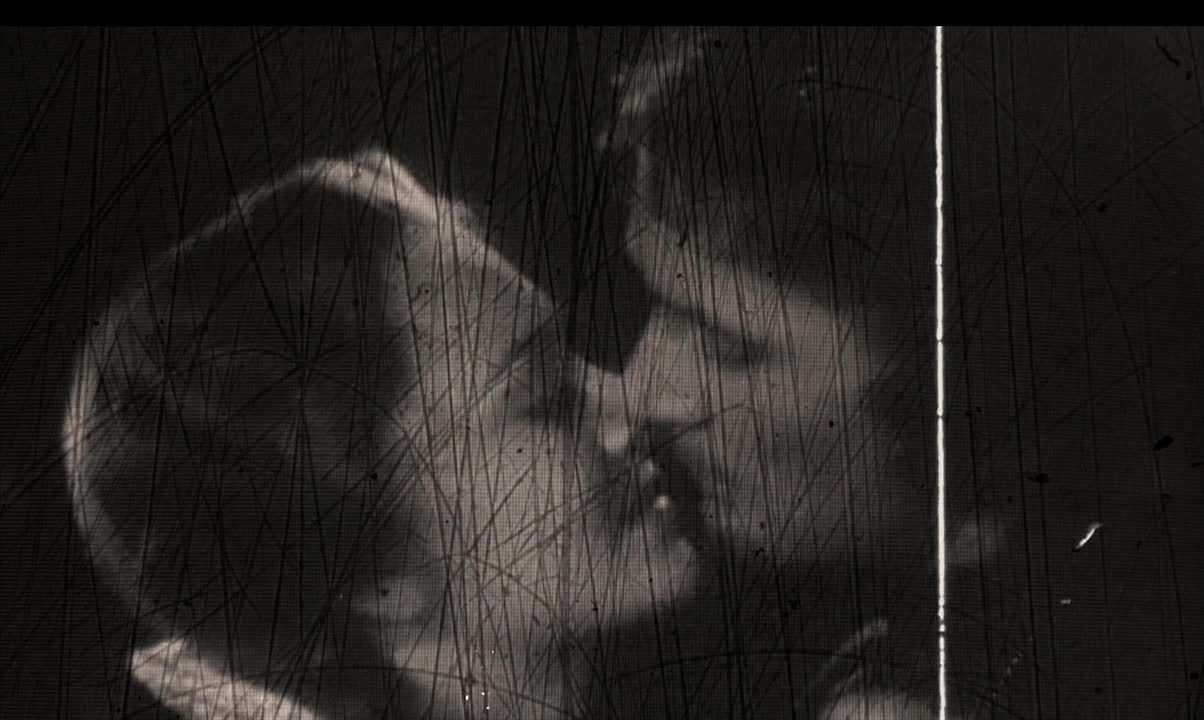 Michael Curtiz & William Keighley’s The Adventures of Robin Hood (1938).
Michael Curtiz & William Keighley’s The Adventures of Robin Hood (1938).
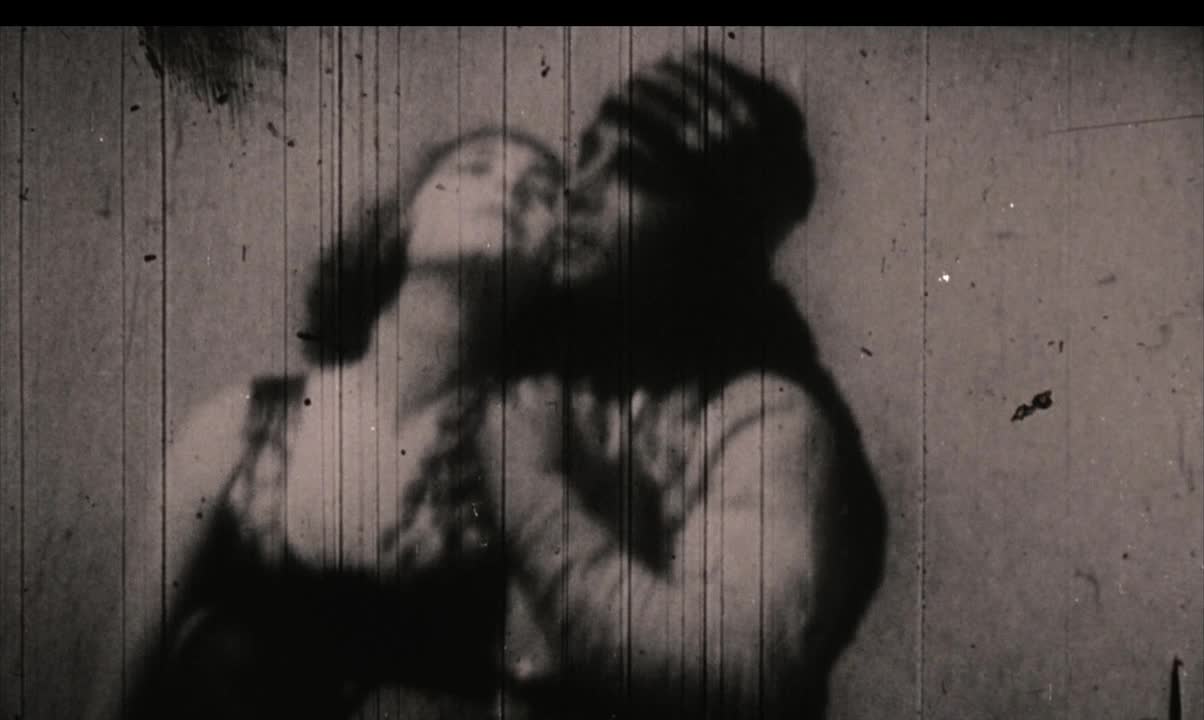 George Fitzmaurice’s The Son of the Sheik (1926).
George Fitzmaurice’s The Son of the Sheik (1926).
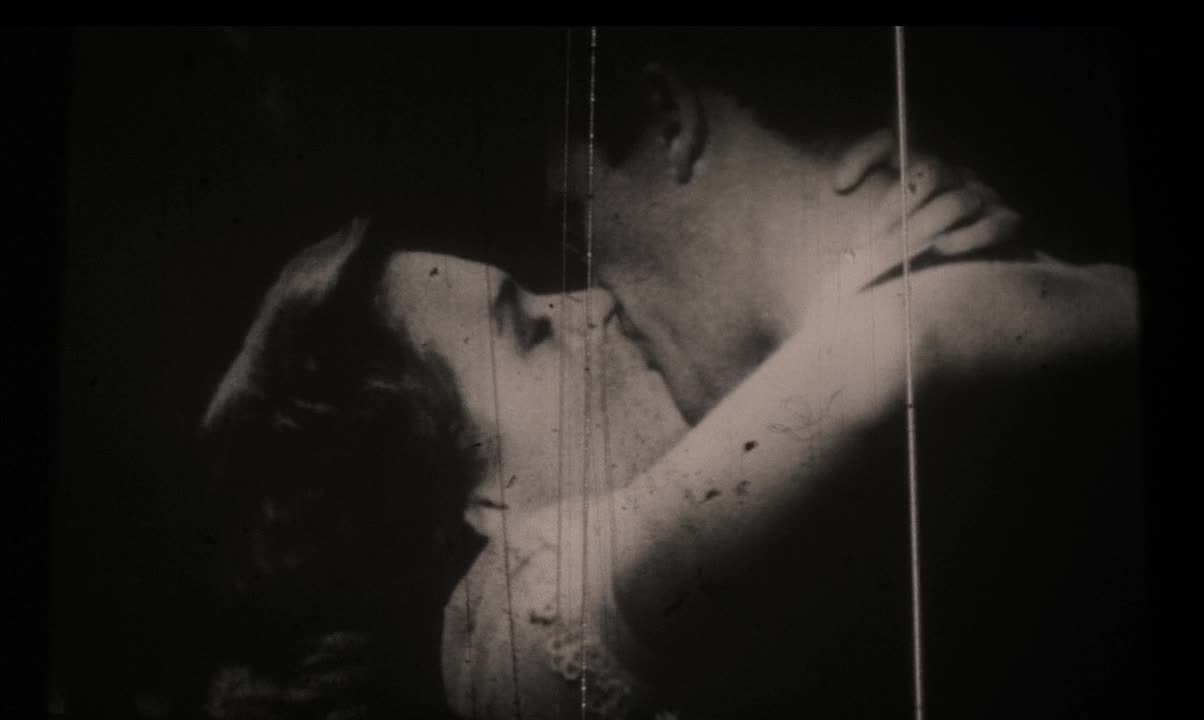 Frank Capra’s It’s a Wonderful Life (1946)
Frank Capra’s It’s a Wonderful Life (1946)
 Luchino Visconti’s La Terra Trema (1948).
Luchino Visconti’s La Terra Trema (1948).
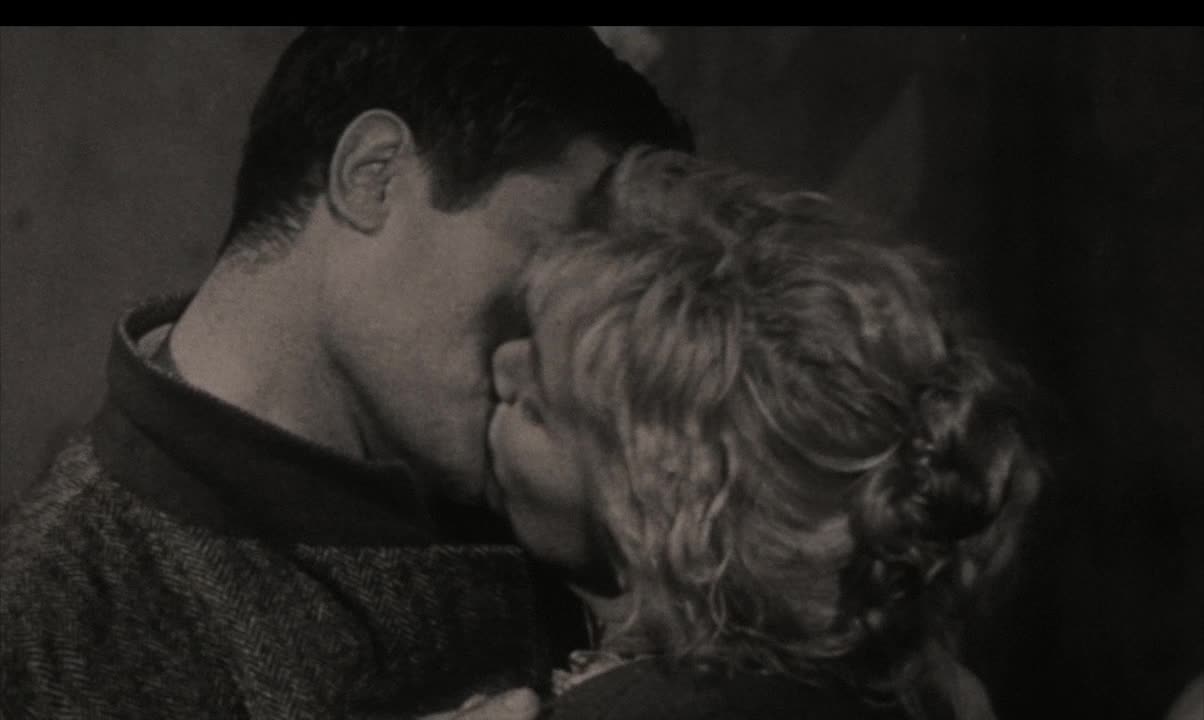 Luchino Visconti’s Le Notti Bianche (1957).
Luchino Visconti’s Le Notti Bianche (1957).
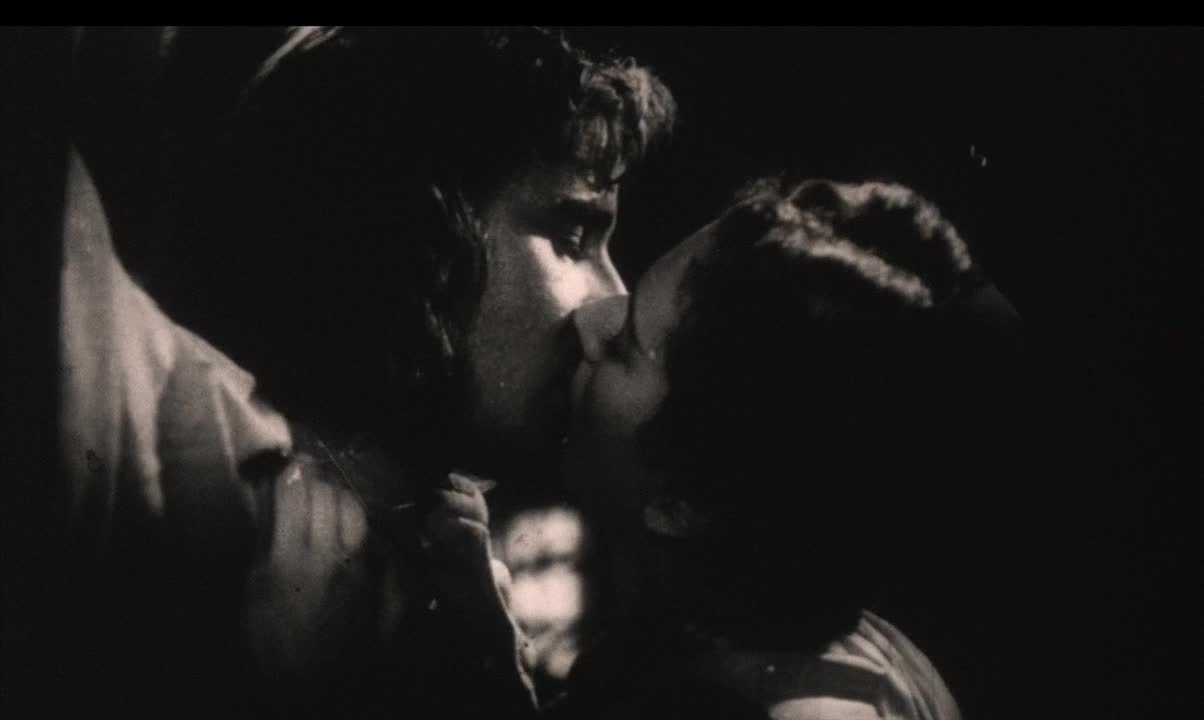 Alessandro Blasetti’s La Cena Delle Beffe (1942).
Alessandro Blasetti’s La Cena Delle Beffe (1942).
 Jean Renoir’s Les Bas-Fonds (1936).
Jean Renoir’s Les Bas-Fonds (1936).
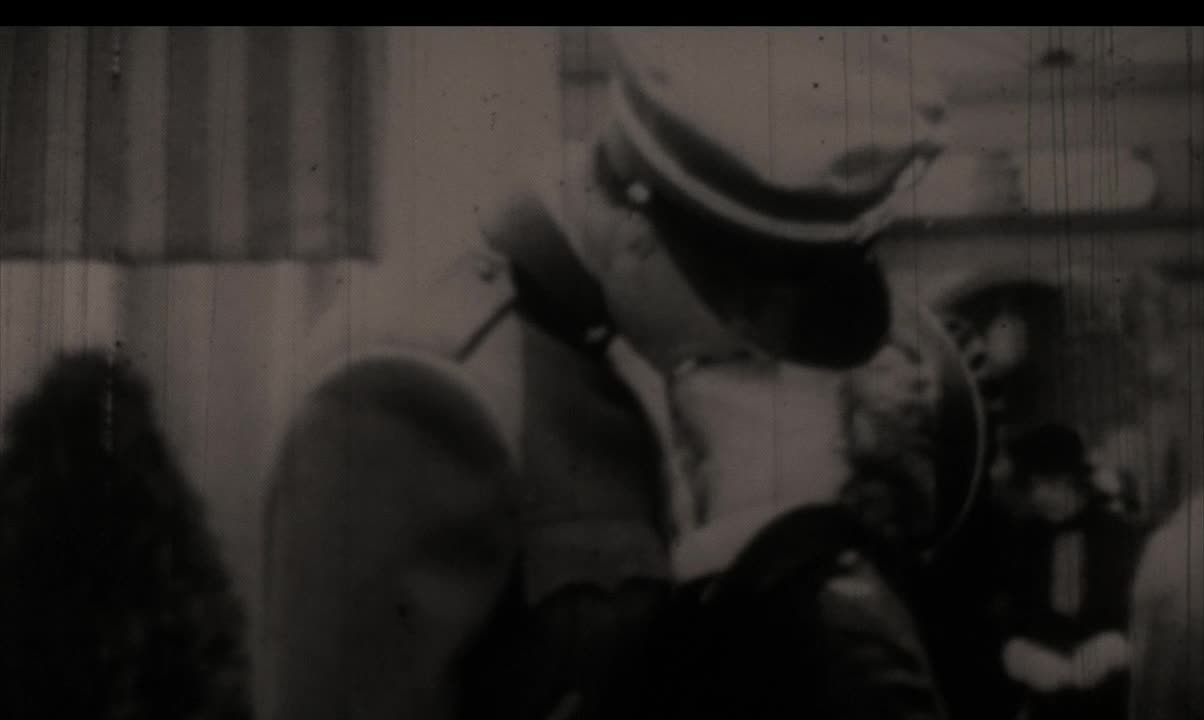 Frank Borzage’s A Farewell to Arms (1932).
Frank Borzage’s A Farewell to Arms (1932).
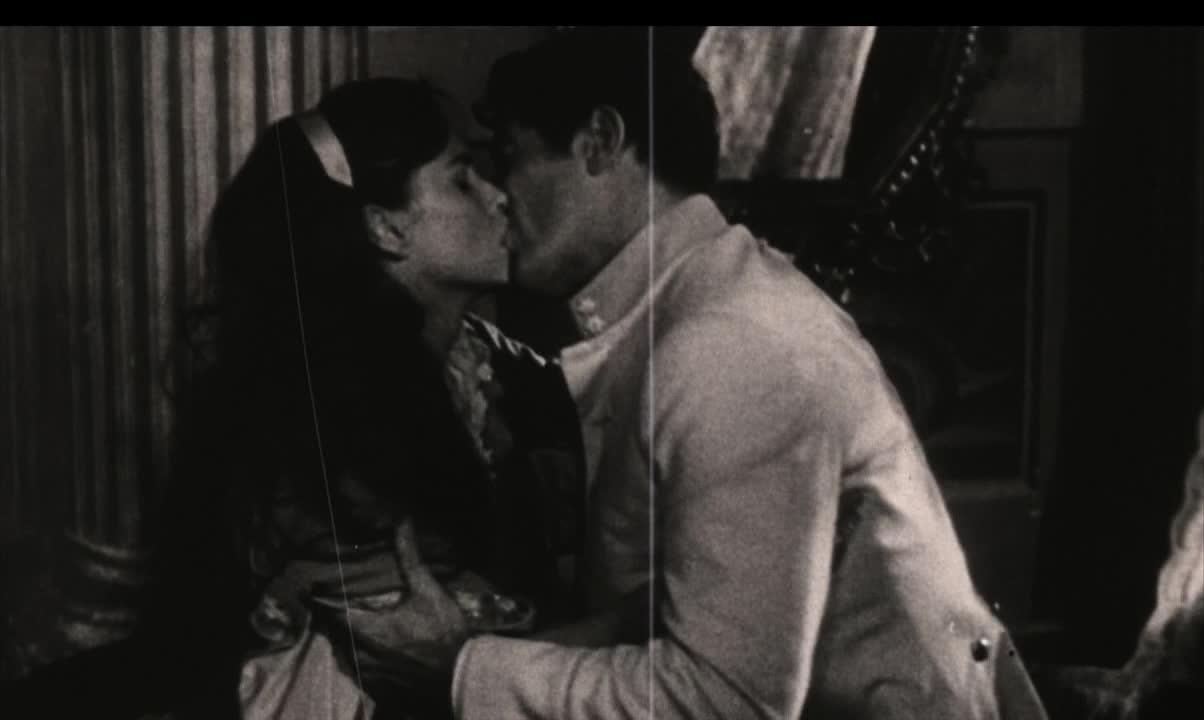 Luchino Visconti’s Senso (1954).
Luchino Visconti’s Senso (1954).
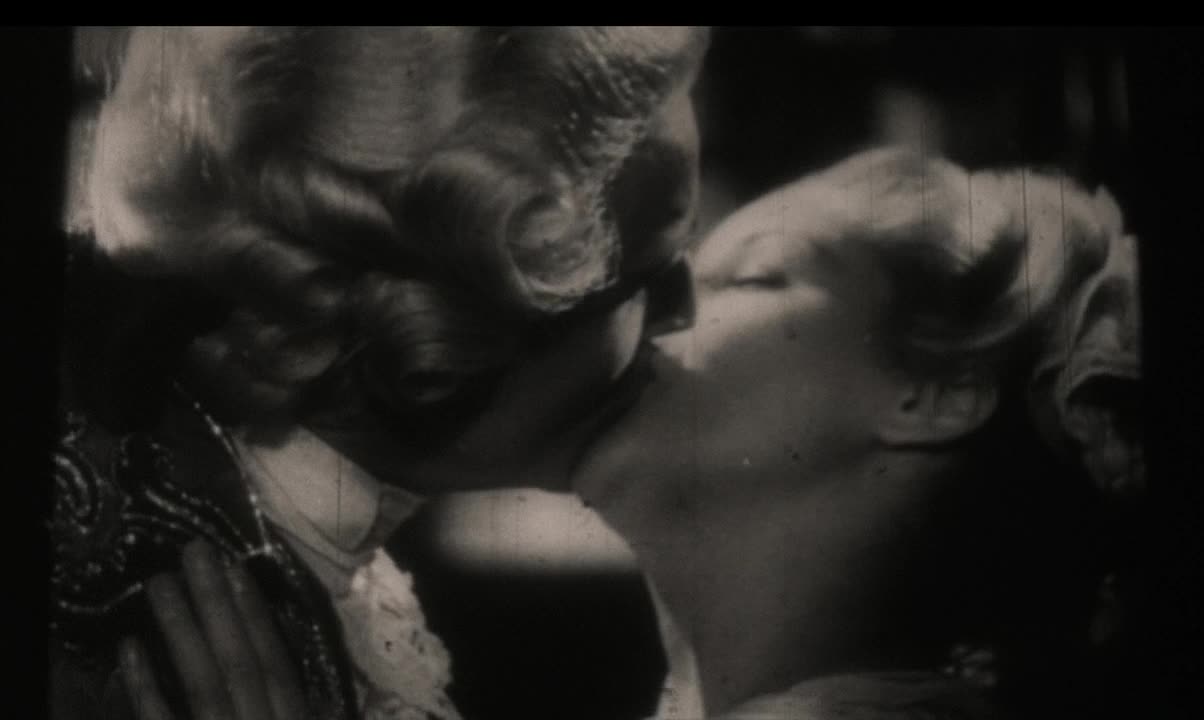 Riccardo Freda’s Il Cavaliere Misterioso (1948).
Riccardo Freda’s Il Cavaliere Misterioso (1948).
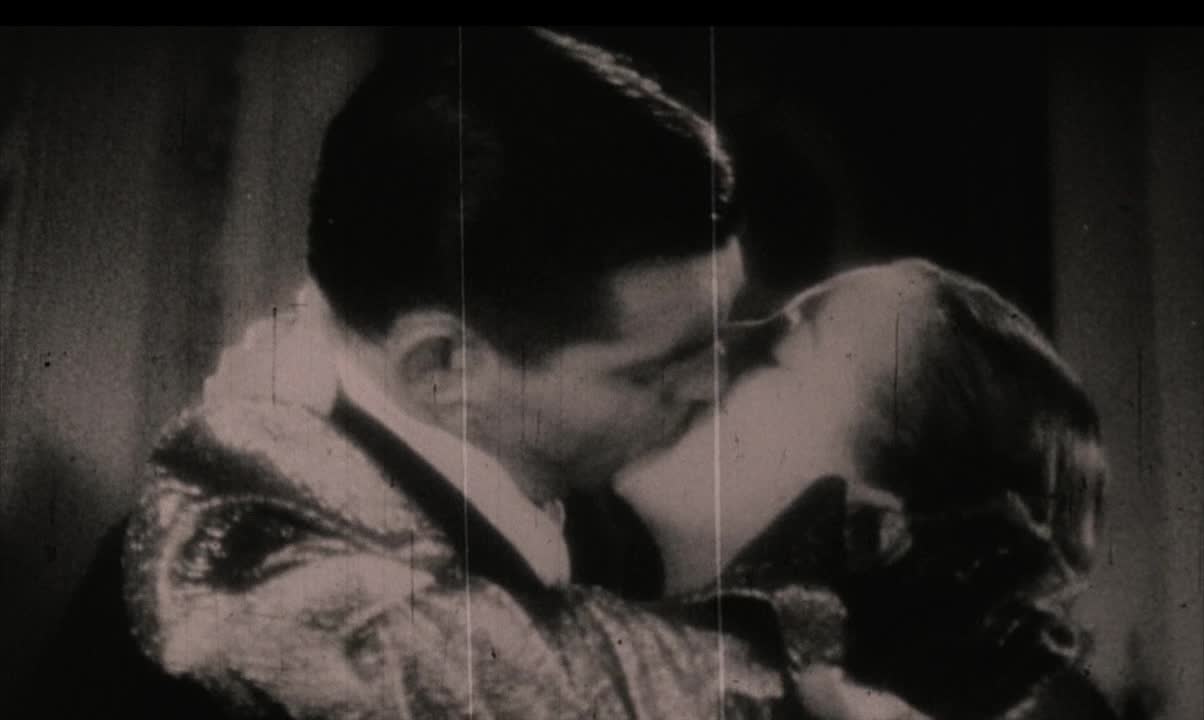 Clarence Brown’s A Free Soul (1931).
Clarence Brown’s A Free Soul (1931).
 Edmund Goulding’s Grand Hotel (1932).
Edmund Goulding’s Grand Hotel (1932).
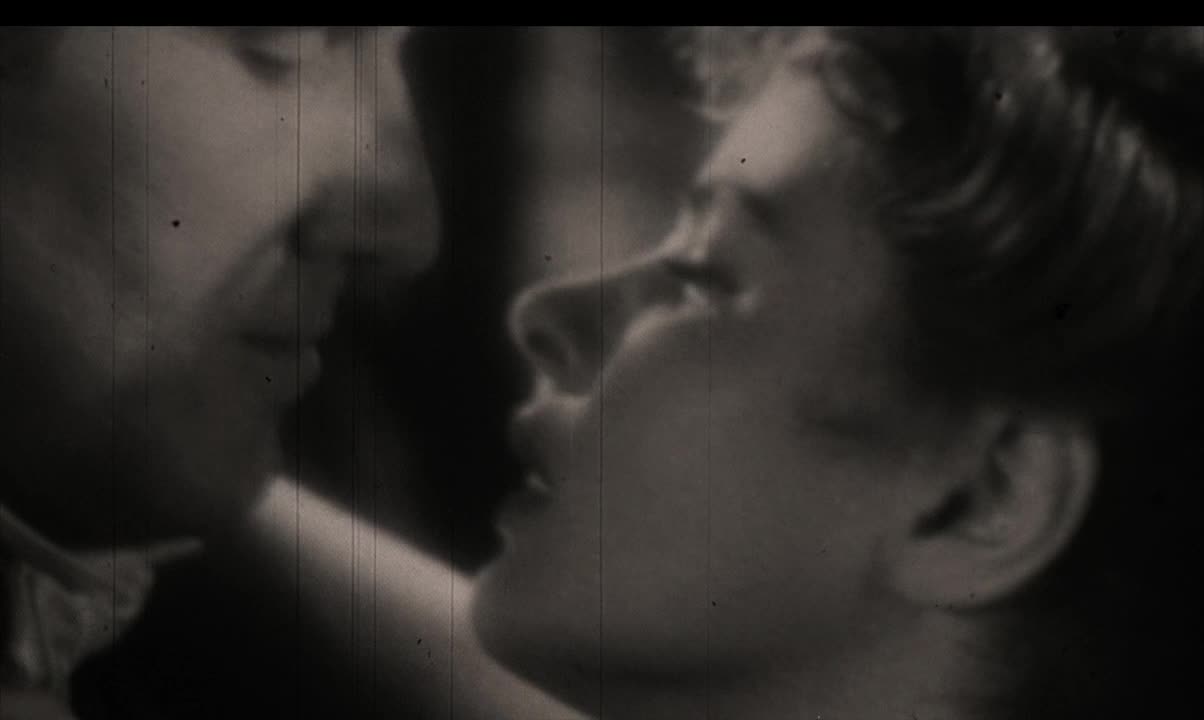 Victor Fleming’s Dr. Jekyll and Mr. Hyde (1941).
Victor Fleming’s Dr. Jekyll and Mr. Hyde (1941).

